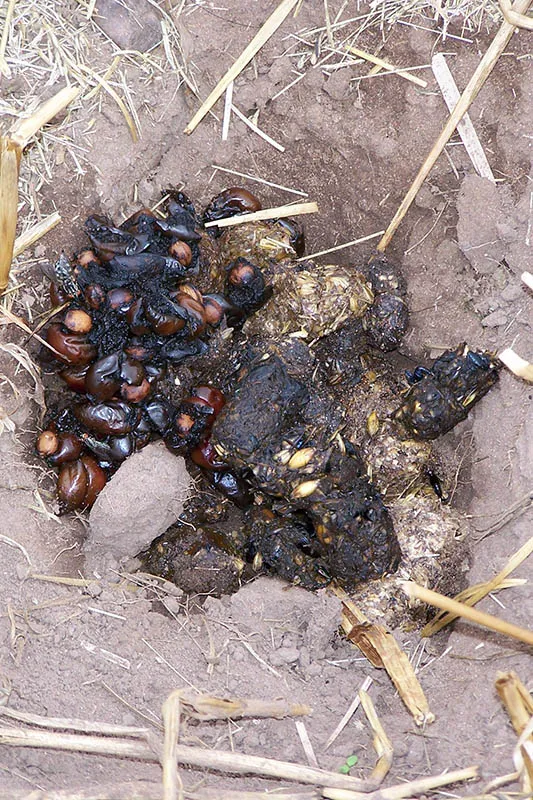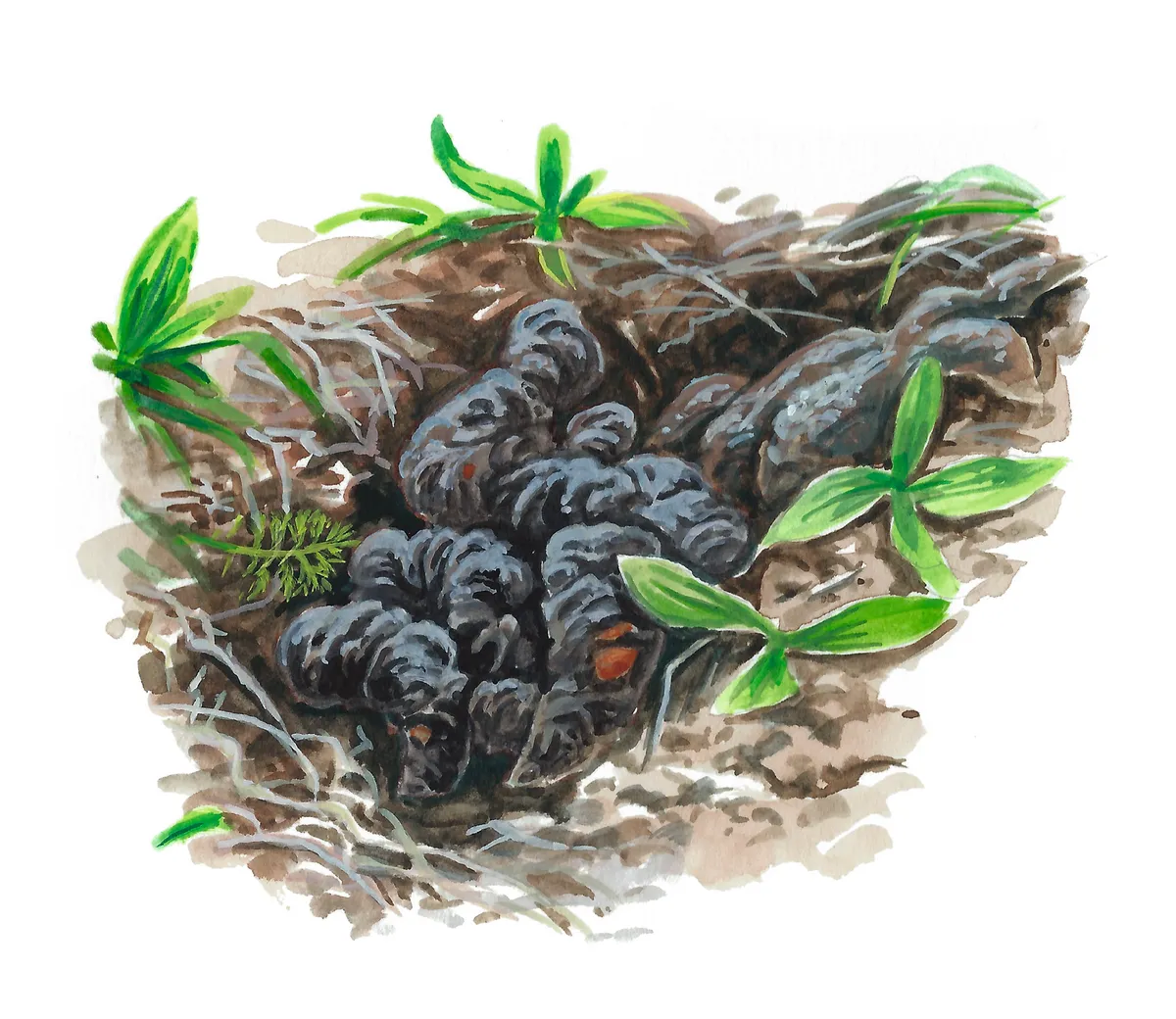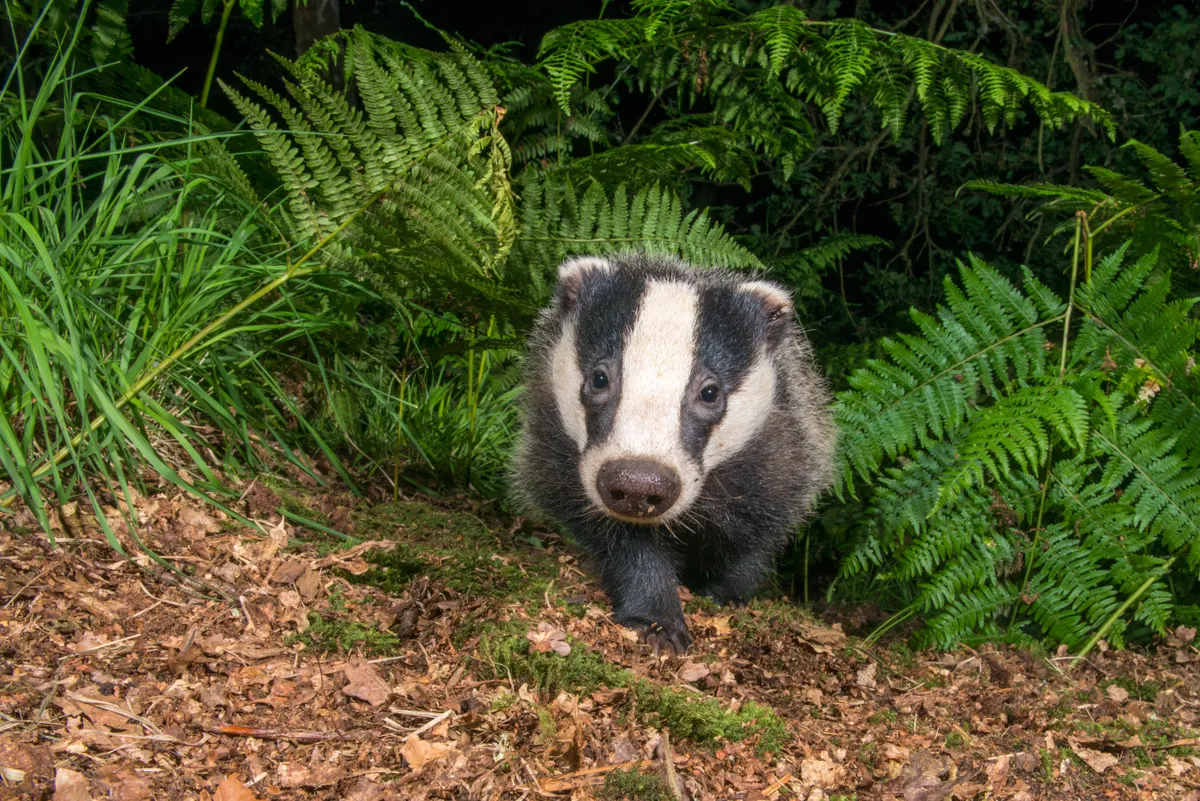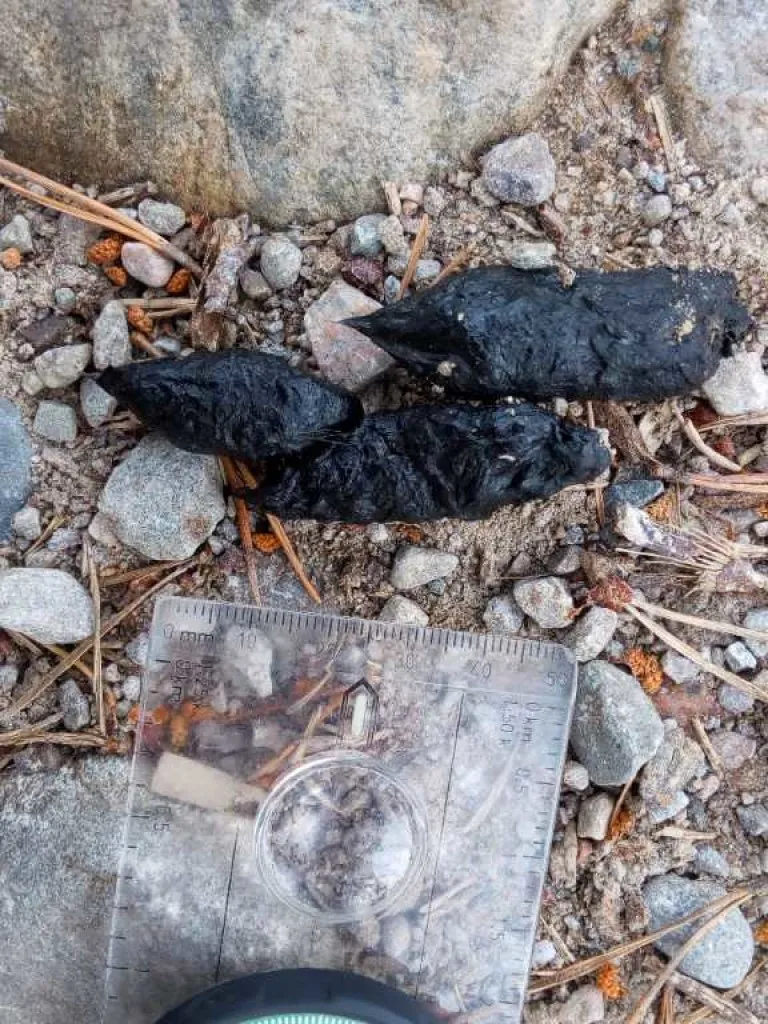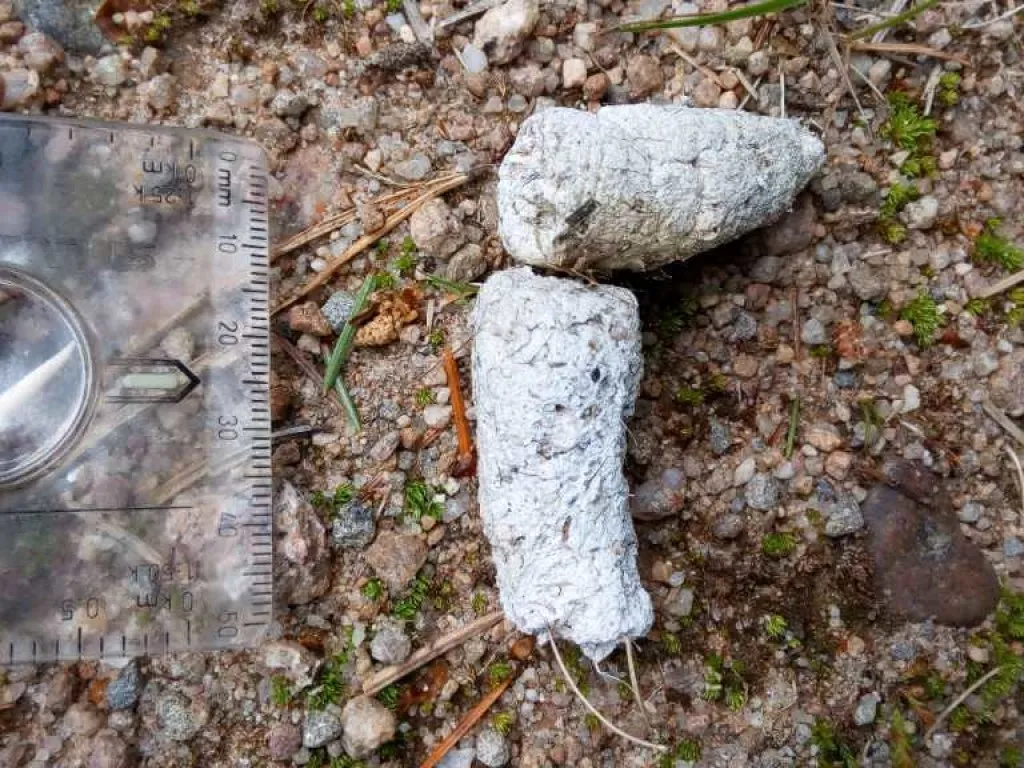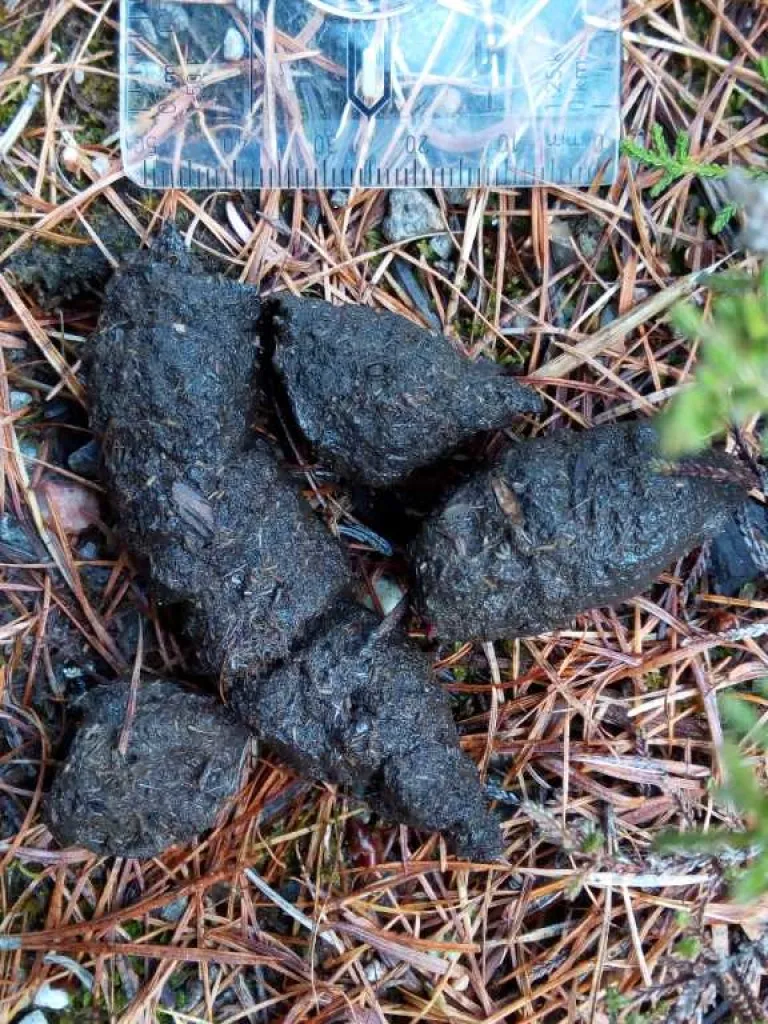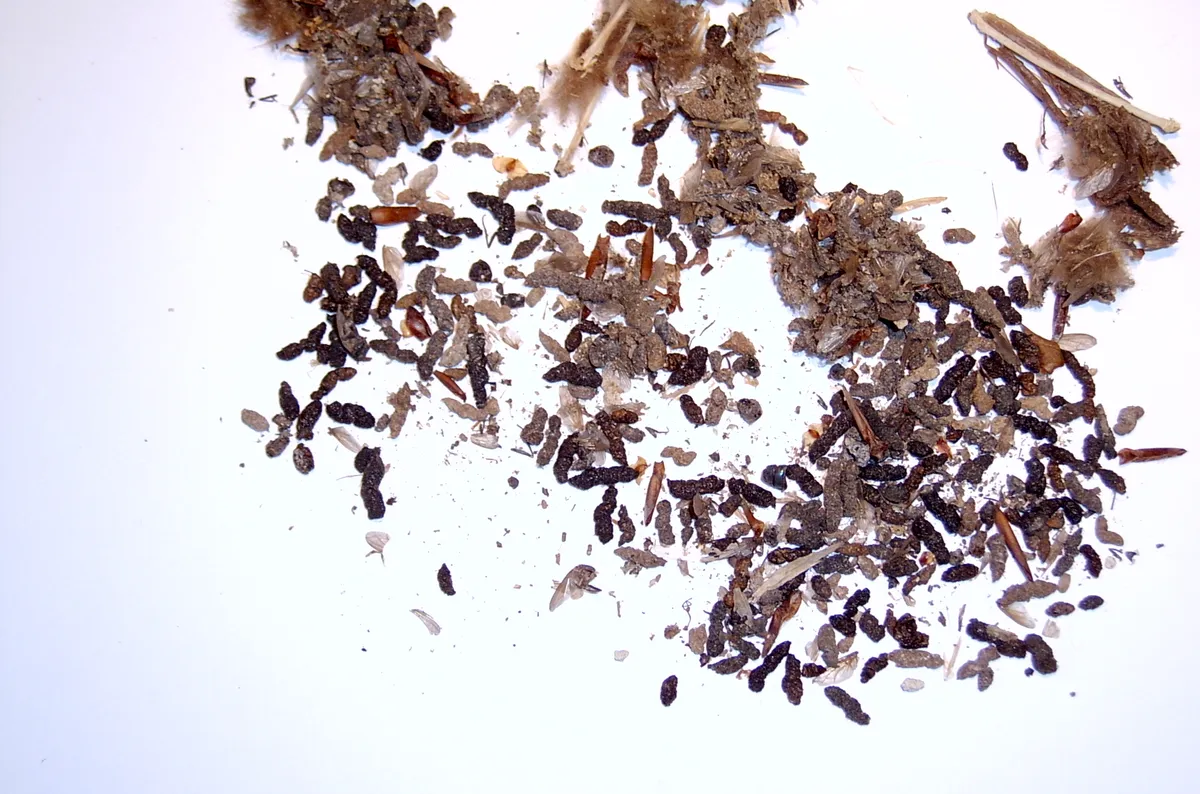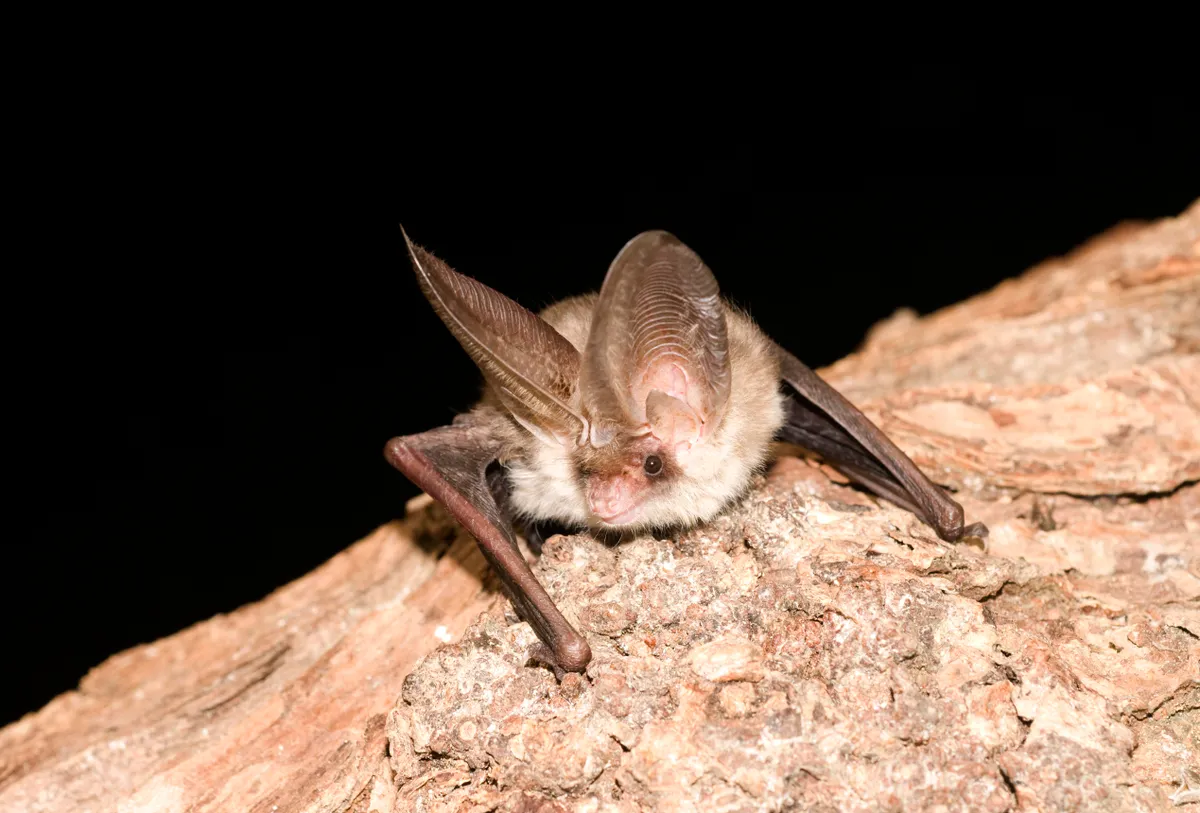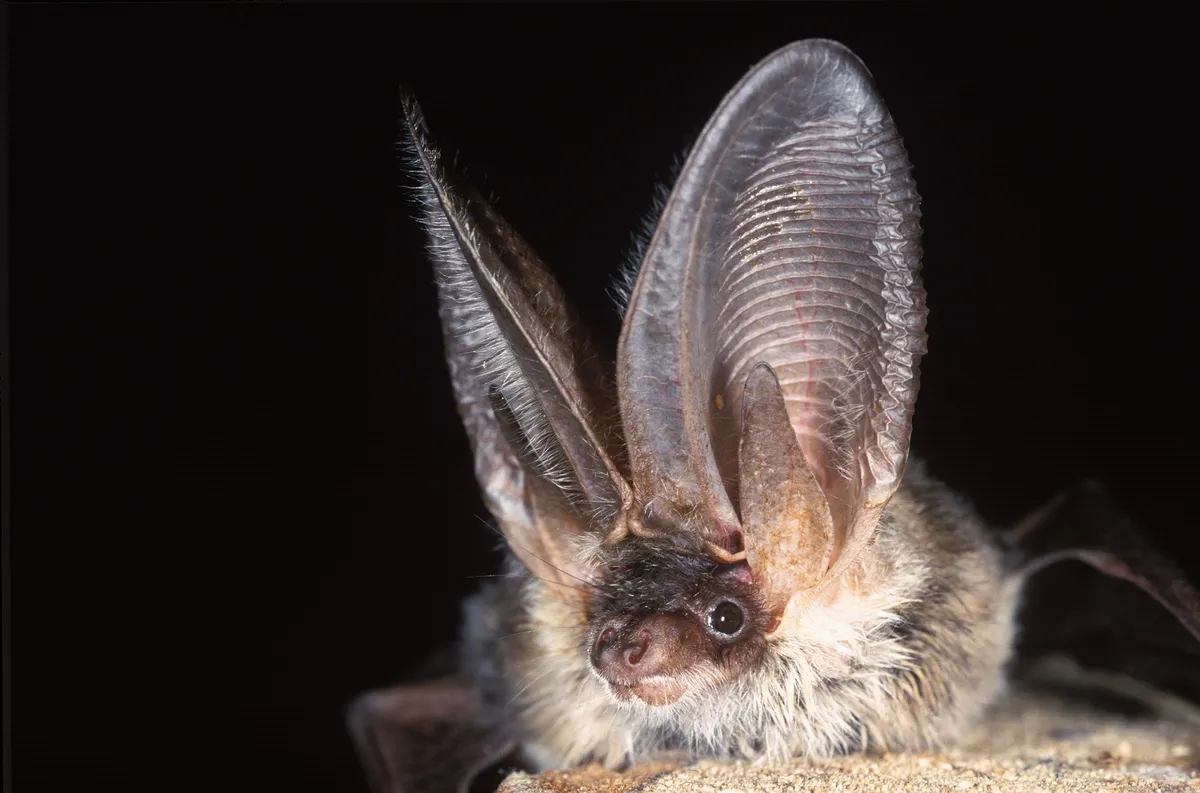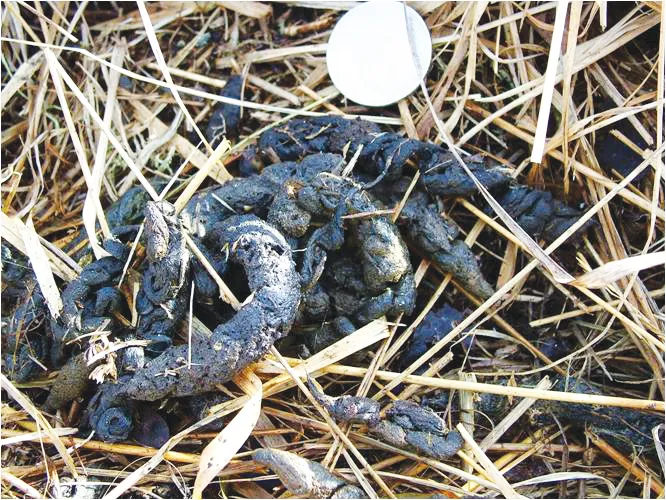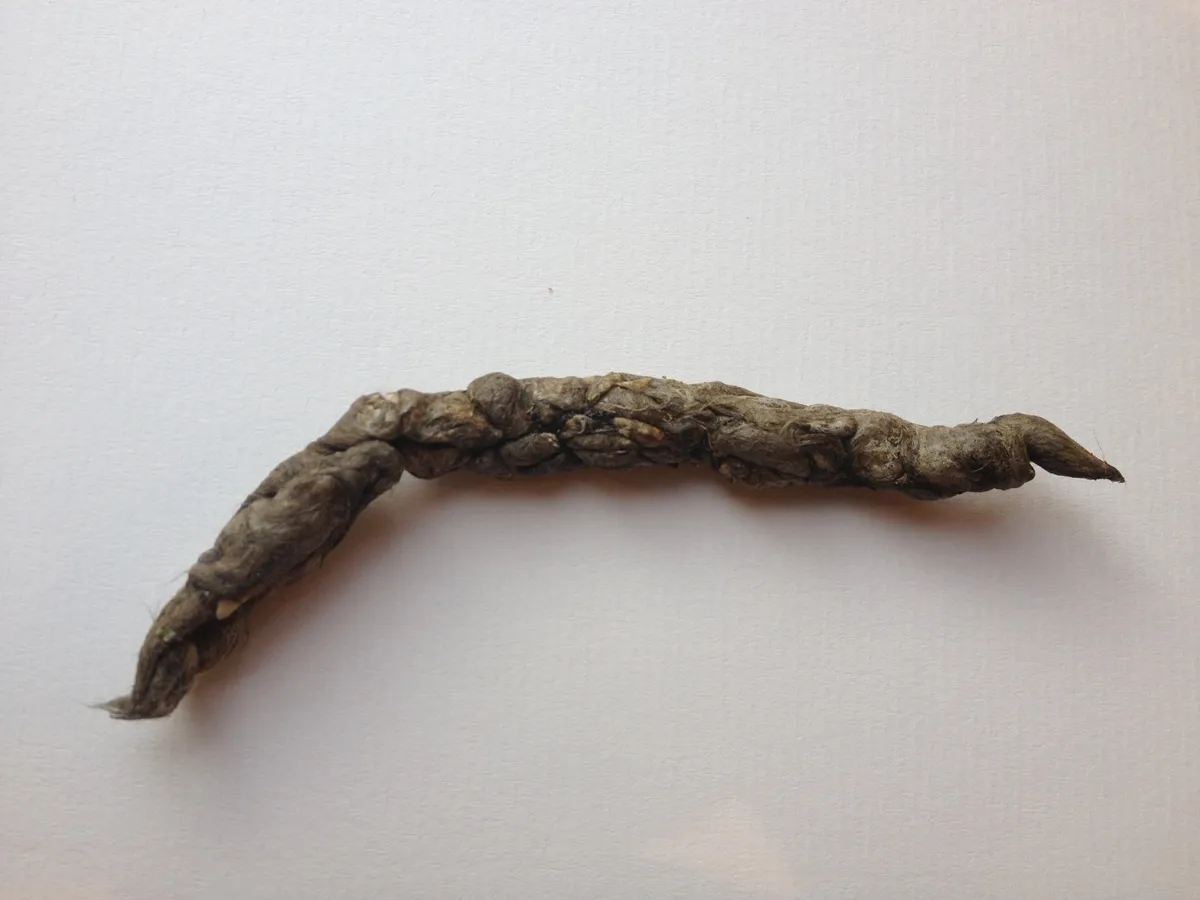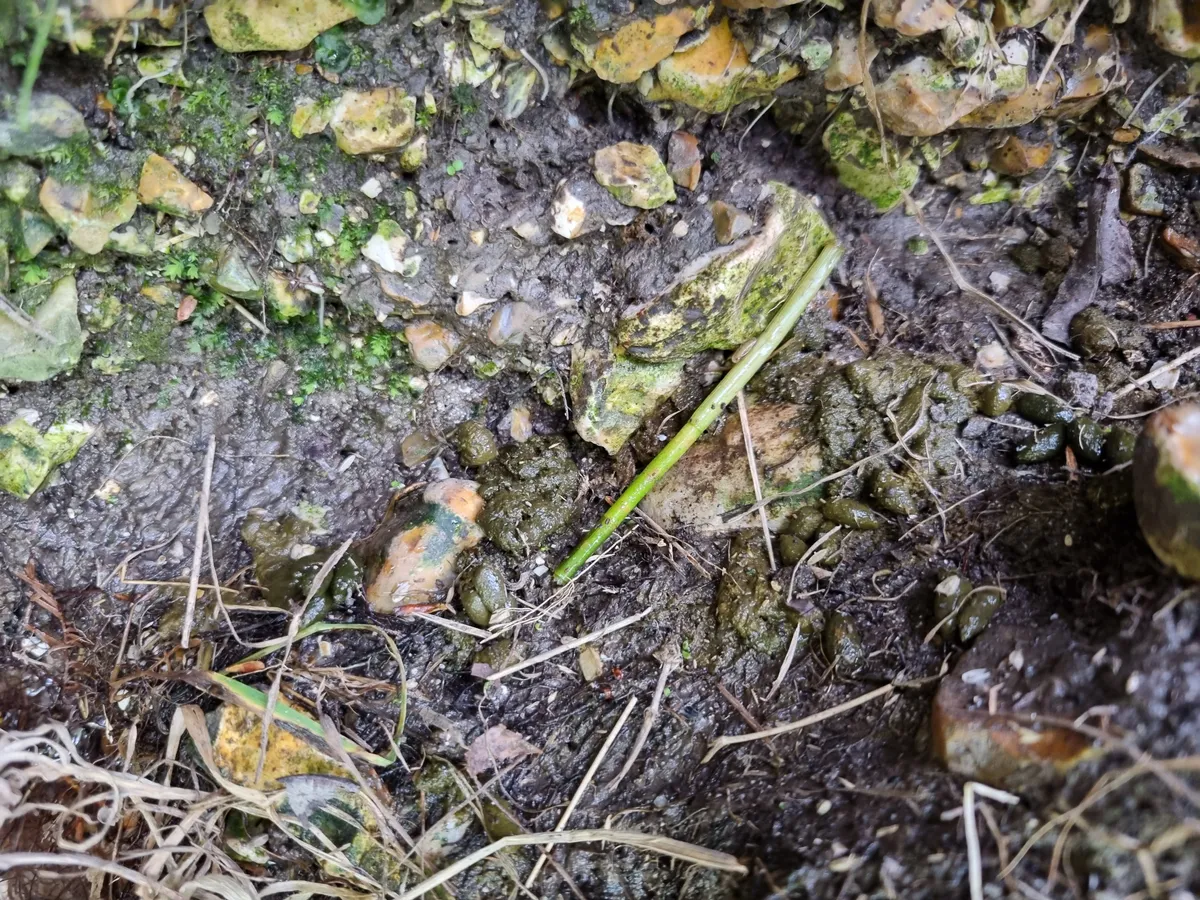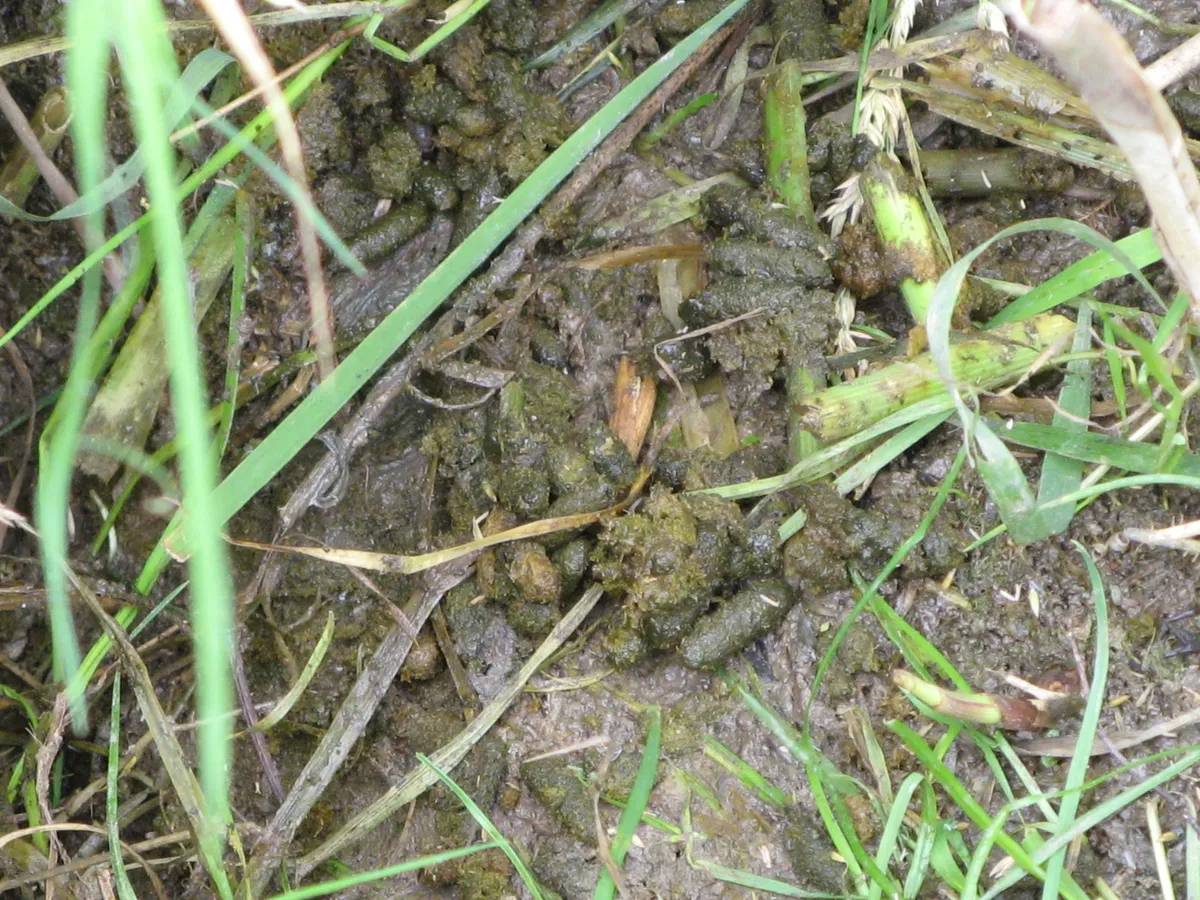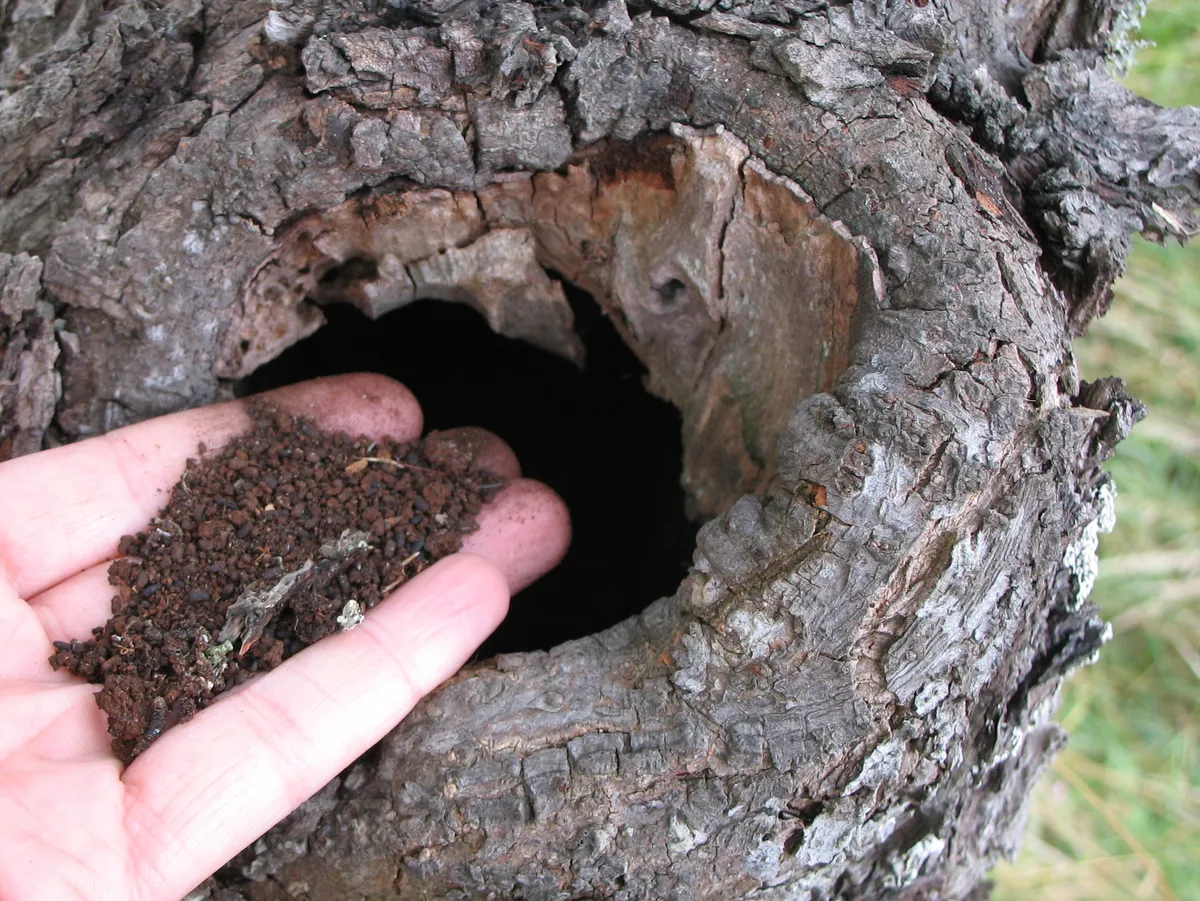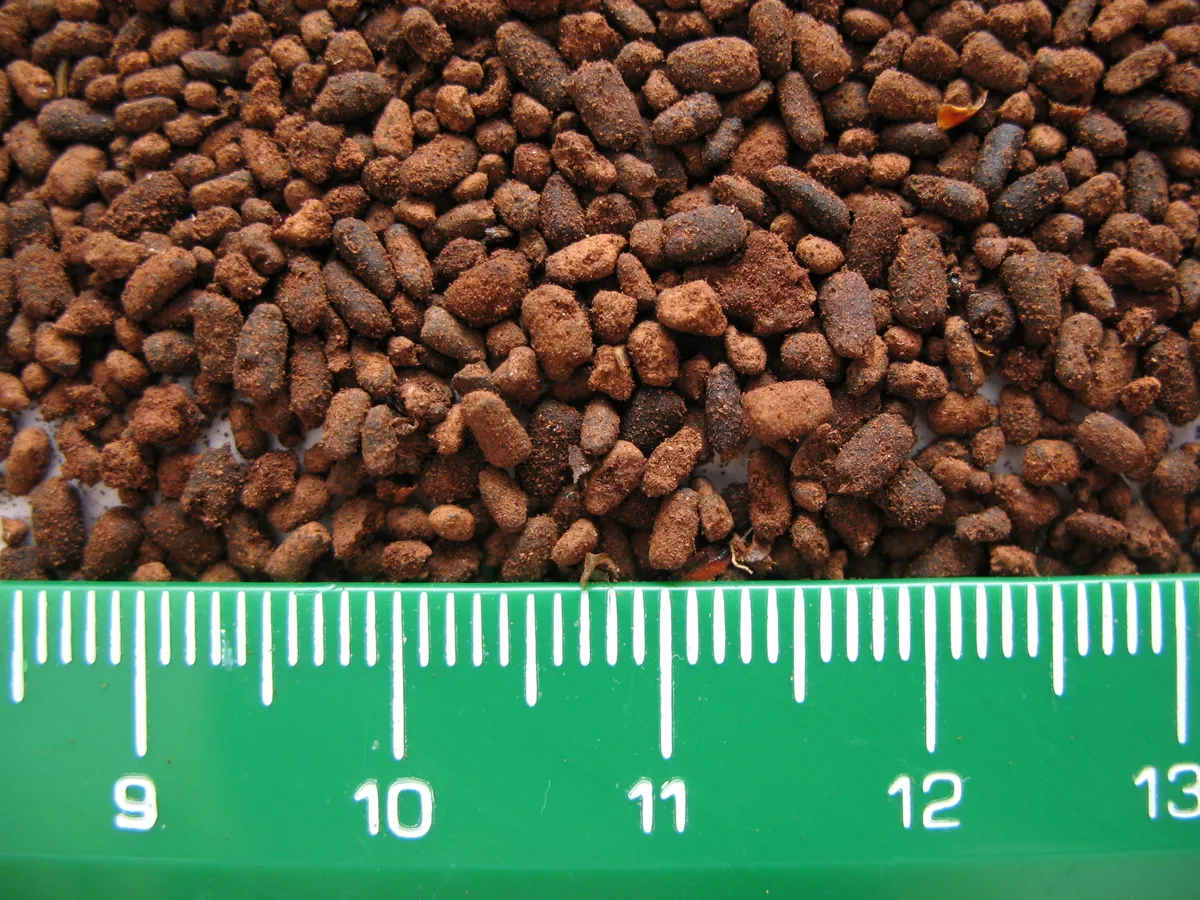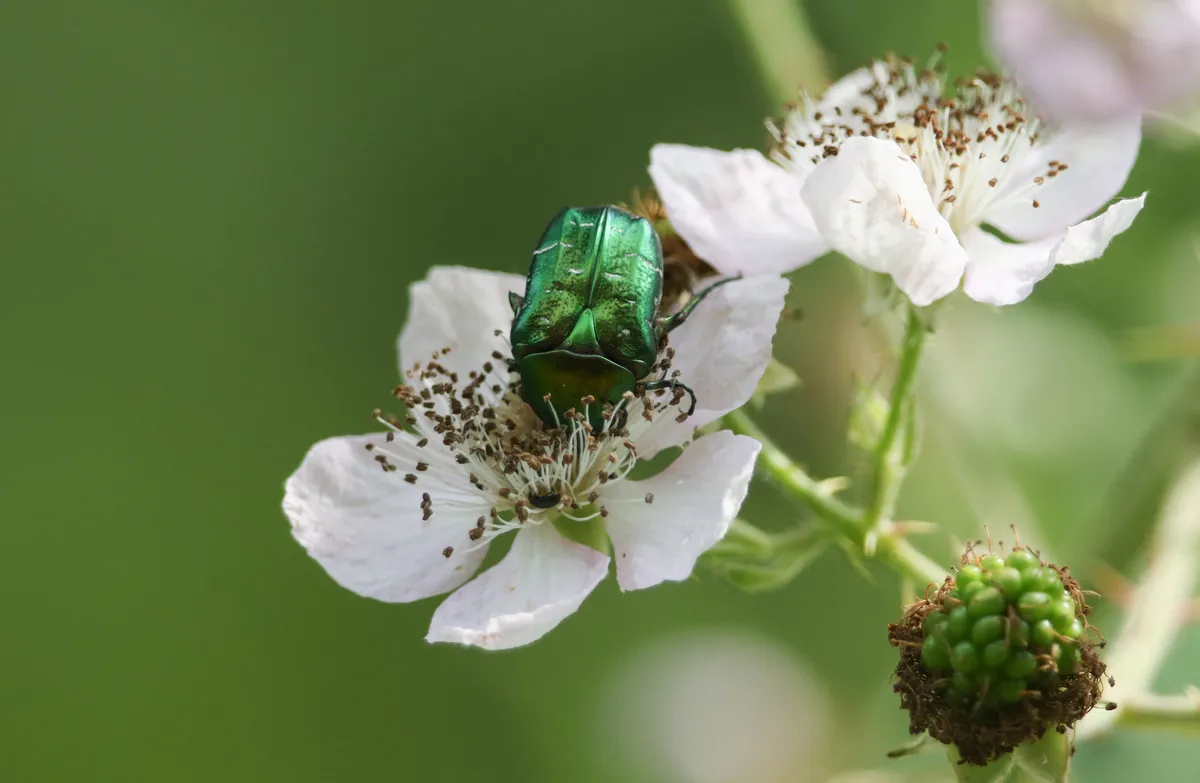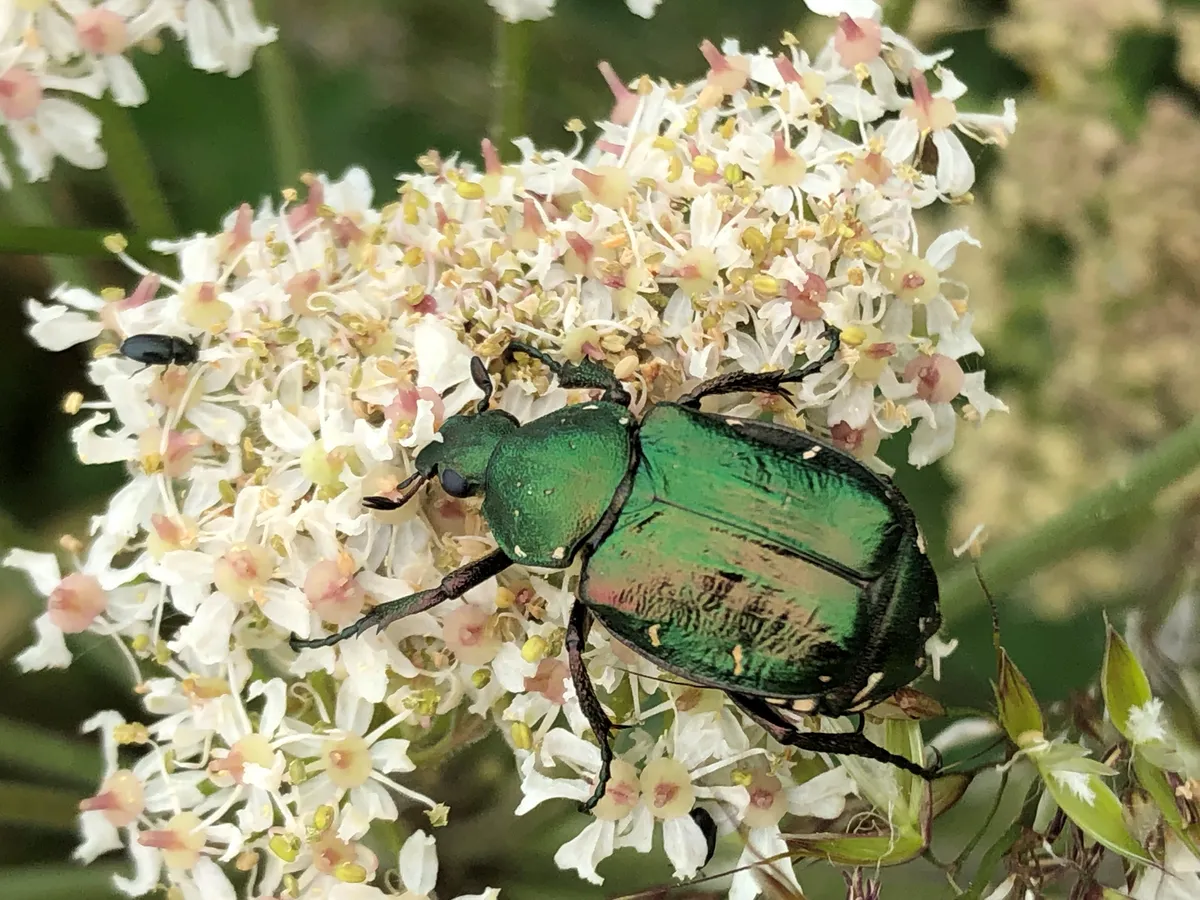Droppings are usually left along territorial boundaries, on prominent features of the landscape or next to discarded prey such as a plucked pigeon, but you can also find them right in the middle of a path, clearing or field. Regularly used poop spots are known as latrines.
While mammal poo is relatively easy to identify, the droppings of different birds often look the same – white splodges containing a paste of waste products. But those of a few species, including the three illustrated here, are more distinctive.
A careful eye, a guarded sniff and (sometimes) a careful inspection using disposable gloves can often reveal the species responsible for the droppings.
Our expert guide to animal droppings or scats will help you identify which species it comes from. Click on each link below to jump to that animal’s droppings in the guide.
Mammals
BADGER • BROWN HARE • EUROPEAN BEAR • FOX • HEDGEHOG • OTTER • PINE MARTEN • POLECAT • RABBIT • RAT • ROE DEER • WATER VOLE • WILD BOAR • WOLVERINE
Birds
CANADA GOOSE • GREEN WOODPECKER • PHEASANT
Insects
All illustrations by Mike Langman
How to identify mammal droppings
European badger poo (Meles meles)
Size: varies
Location is key when trying to identify badger poo.
“Badgers use their droppings to mark the boundaries of their territory, which can lead to poo wars when badger clans try to ‘out-poo’ each other at the key meeting points of their territories,” says Derek Crawley from the Mammal Society.
“They also have a latrine area just away from the set as it is one of the things we all do shortly after waking up. Most poo is deposited in a pit but if the ground is too hard to dig (rocky area) they will leave it on the surface.”
Containing seeds and berries, droppings are usually purple, black or brown in colour and smell foul – “a strong musky, oily smell”. The consistency can vary considerably depending on what they’ve been eating, for example if they’ve been eating a lot of worms, then it is very sloppy.
The scientific name of the European badger, Meles meles, is an example of a tautonym, where the genus and specific name are the same.
Related content:
©Getty
Brown hare poo (Lepus europaeus)
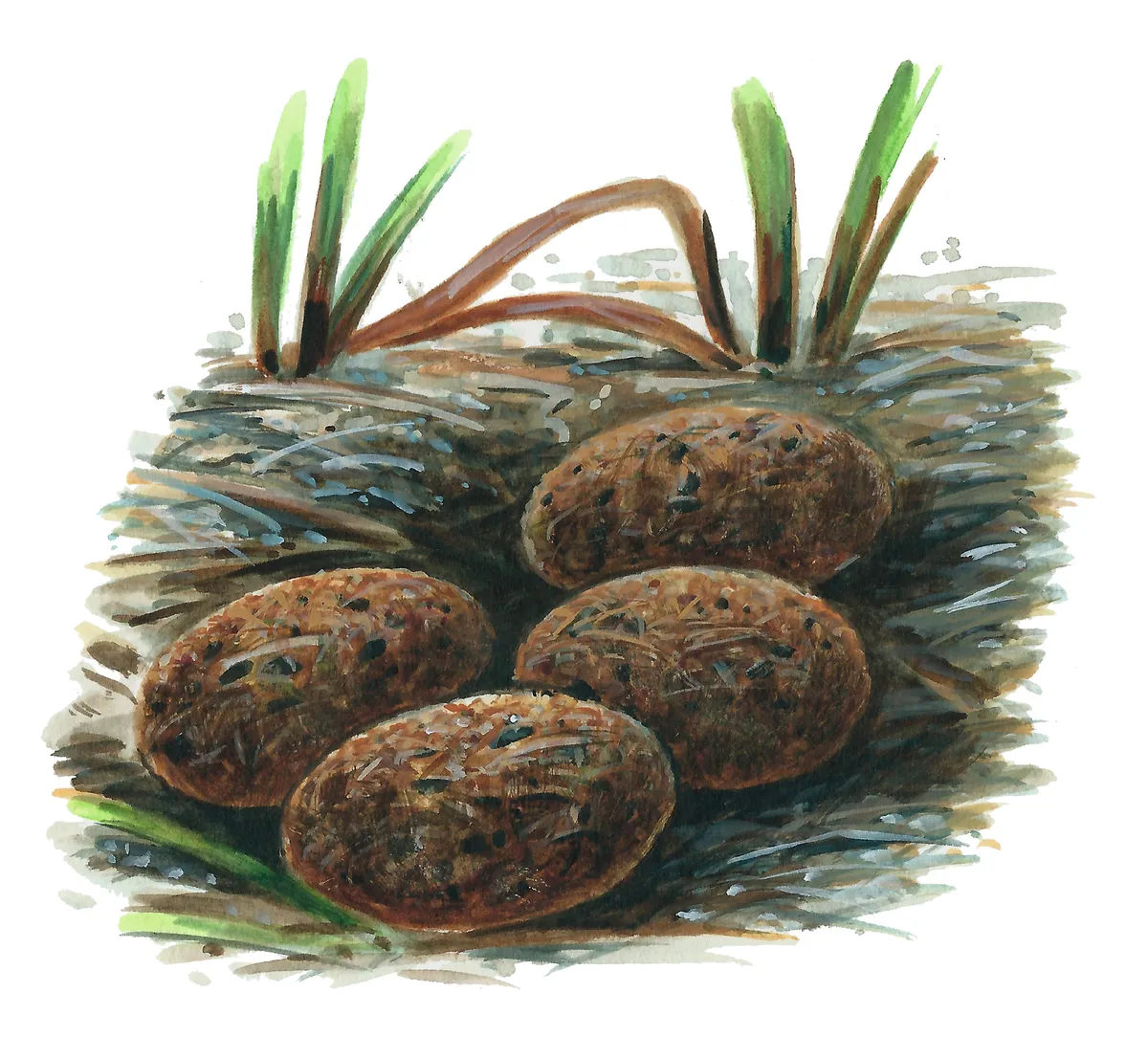
Size: 1.2–1.5cm
Hare droppings are like rabbit droppings but larger, flattened and more fibrous, containing larger bits of plants. They are usually quite sweet-smelling and can be found in hare scrapes. They're also more likely to be found away from field edges.
Did you know that hares and rabbits eat their own droppings?
All lagomorphs (rabbits and hares) eat their droppings as soon as they pass. This is known as refection, and it allows the animals to extract extra value from their plant food.
Grass is incredibly hard to digest because of its high cellulose content. Unlike cows and other ruminants, lagomorphs cannot chew the cud.
Instead, they excrete soft green pellets known as cecotropes, which they eat - giving them the chance to metabolise their food again and get some extra nutrients.
Find out more in our wildlife Q&A with naturalist Polly Pullar.
European brown bear (Ursus arctos arctos)
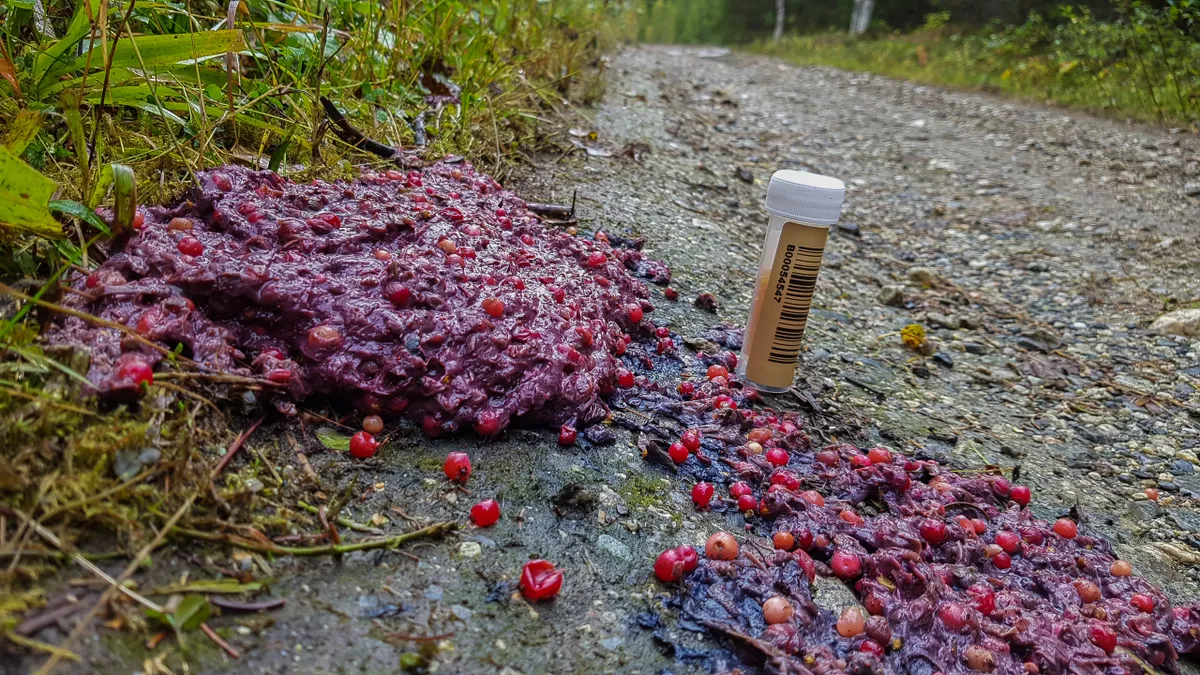
In addition to meat, brown bears are known to eat wasp nests, beehives, fruits and even grass. Their omnivorous diet is evident in their scat, which changes in shape, form, content and smell with the seasons. Bears excrete faeces as they walk, so the scat gets spread out rather than clumped together.
In spring and summer, there’s meat but also anthills and leaves, whilst in autumn, they eat berries to fatten up for winter. “The scat is most striking in autumn when they’re eating lingonberry or blueberry, it’s like a porridge of berries” says Alexander Kopatz from the Norwegian Institute for Nature Research (NINA), who analyses the bear DNA within the scat to track bear populations. “It’s violet-blue in colour and smells sweet.”
The high sugar content of berries is ideal for building up fat reserves for denning (which is different to hibernation) from between October or November to March or April.
Scientists sometimes collect scat from bear dens, where the females have given birth over winter. Cubs have different scat over winter, since they are drinking milk from their mother and so it is much more liquid in consistency.
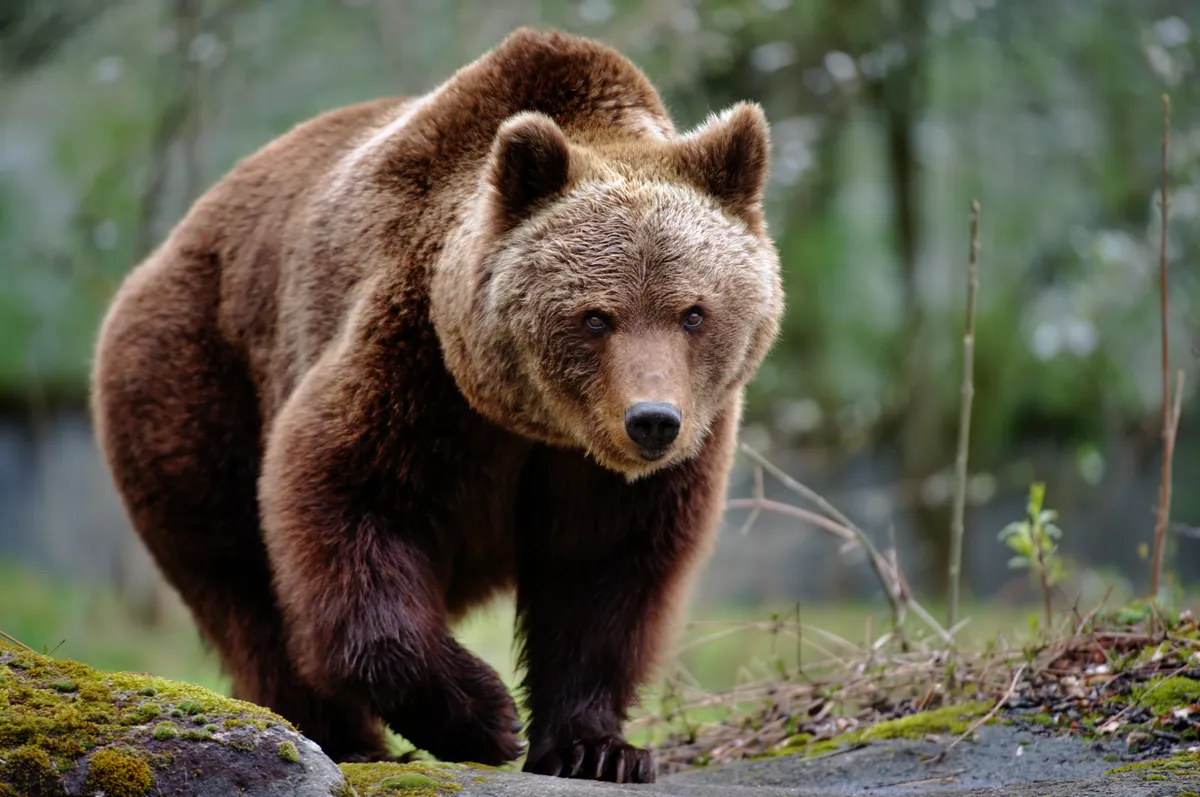
Red fox poo (Vulpes vulpes)
Size: 5-20cm
The colour and smell of red fox scats can be vary widely depending on the season and diet. When feeding on small mammals and carrion in the winter, scats are coloured light grey to black. Whereas they can be red and purplish in the summer and autumn, when foxes are feeding are berries and insects.
“Though the smell will vary, they retain a musky smell due to secretions from their anal glands,” says Dr. Cristian Navarro Waggershauser, a research fellow at the University of Aberdeen. “However, the most reliable diagnostic is the thickness, with fox scats being between 12 and 25mm.”
Scientists undertaking a study on the diet of red foxes in the Scottish Highlands used DNA analysis to identify what the foxes had been eating and were surprised to find that a large proportion of fox faeces contained domestic dog DNA. “After testing and discarding several hypotheses, including predation of dogs and laboratory artefacts, we concluded dog faeces were the source of dog DNA,” says Navarro Waggershauser. “We then tested the calorific content of dog faeces using a technique called calorimetric explosion where we exploded them to measure how much energy they contain.”
They found that there was a similar energy content from the dog faeces as the wild prey of foxes. However, dog faeces are easier to “hunt” and it’s thought that the faeces become an important food source during times of scarcity.
“Interestingly, we found other examples of wild animals feeding off the faeces of other species,” adds Navarro Waggershauser, “and wonder if this has been an overlooked behaviour that could shift our understanding of how species interact.”

The scientific name of the red fox, Vulpes vulpes, is an example of a tautonym, where the genus and specific name are the same.
More related content:
Two red fox kits on their hind legs fight playing. © Carlos A Carreno/Getty
European hedgehog poo (Erinaceus europaeus)
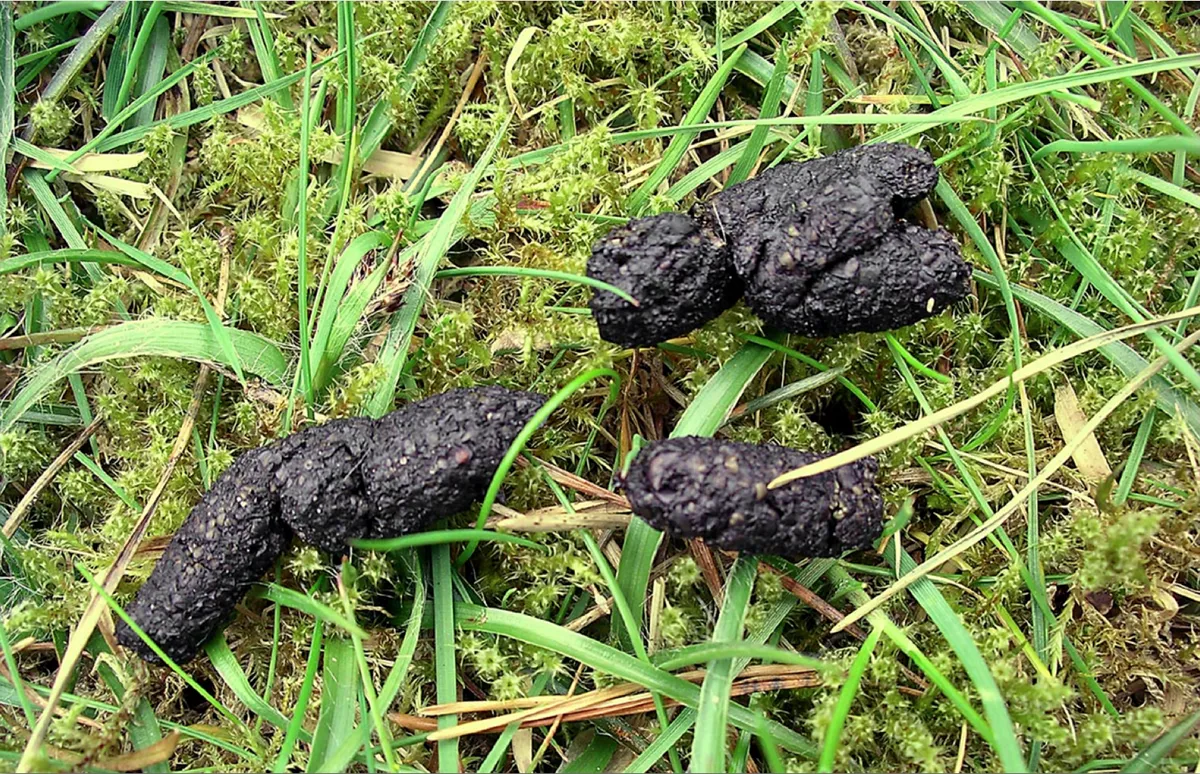
Size: 1.5-5cm
Hedgehog droppings can range from 1.5 to 5cm in length, and are dark brown, grey or black. Usually found as a singular dropping, the poo smells mildly unpleasant, described as having a hint of linseed oil. Droppings are cylindrical, sometimes tapered on one end. “Look for shiny bits, which are often present – they’re remnants of invertebrates, such as beetles,” says Fay Vass from the British Hedgehog Preservation Society.
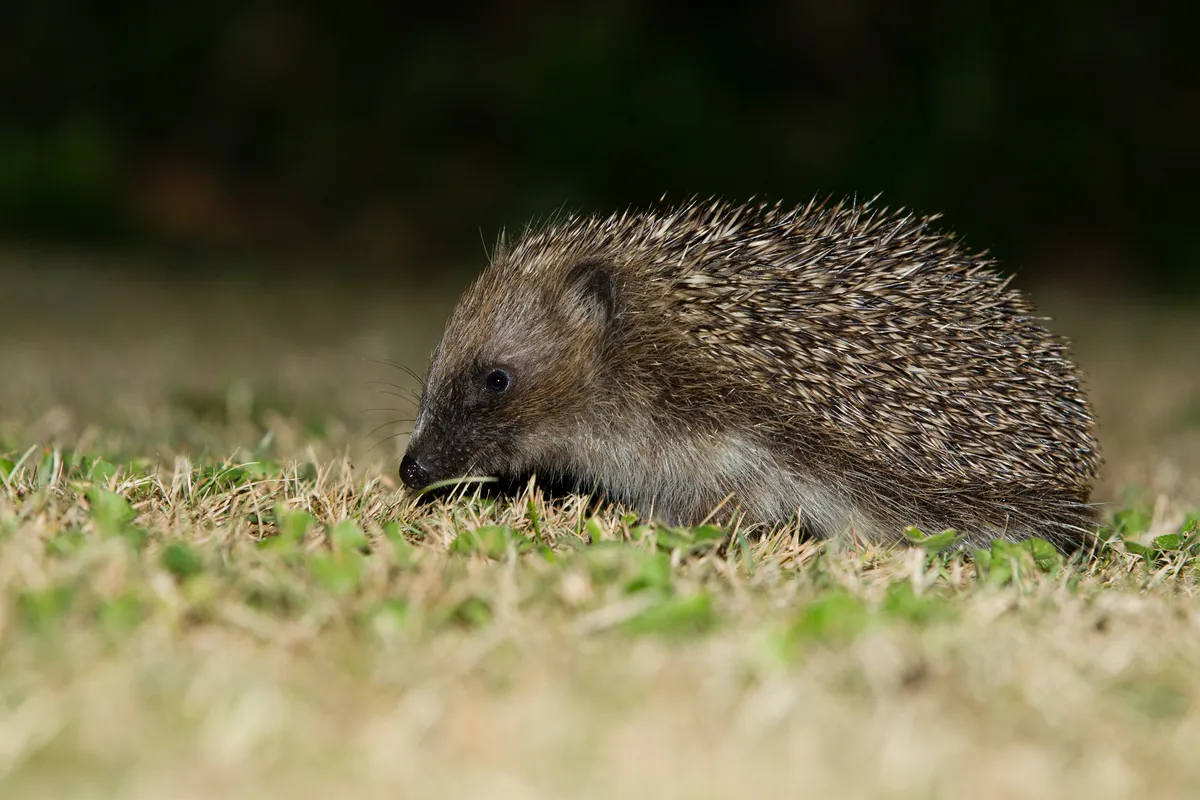
Long-eared bats (Plecotus sp.)
When surveying for bats, droppings are a key indication of presence. Although there can be subtle differences between species, sometimes DNA analysis is required, which is the case when trying to tell apart brown long- eared bat and grey long-eared bat droppings.
Claire Boothby, Bats in Churches Project training and survey officer, says, “The grey long-eared bat is one of the rarest mammals in Britain with a populaton estimated to be as low as 1,000 individuals, so every new roost we find is of importance.”
Eurasian otter poo (Lutra lutra)
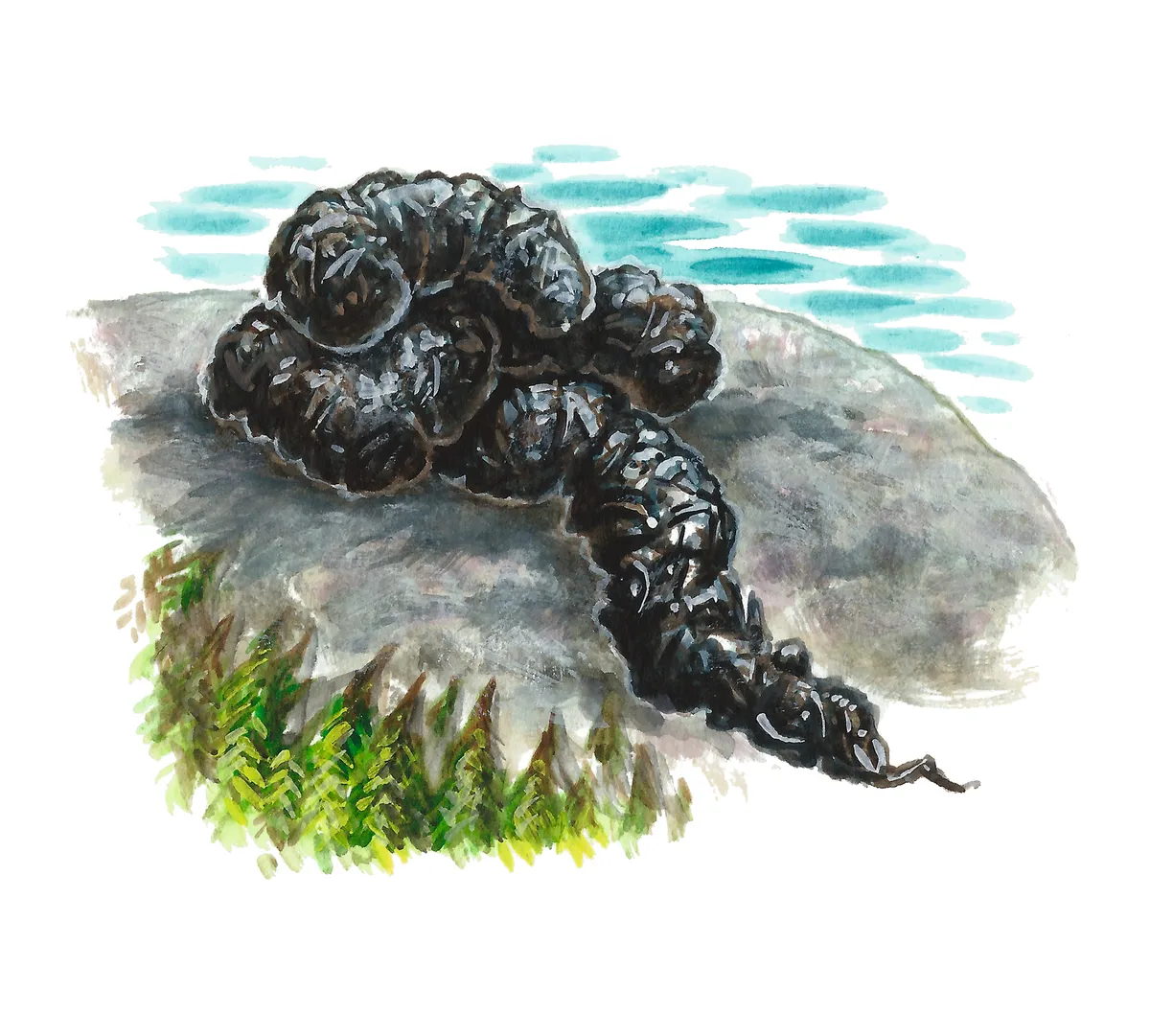
Size: 3-10cm
Known as spraint, otter droppings are normally coarse and black, full of fish scales, shell fragments, fish and crayfish parts, and sometimes feathers or fur. As otter poo dries out, it becomes pale and crumbly. Otter spraint may also just be oil deposited to mark a territory.
Whether or not it contains poo, otter spraint has a unique smell - some people describe it as a very musky and fishy smell, with a sweet taint surprisingly similar to jasmine tea.
Look for otter spraint in prominent spots along a stream, lake or river, such as grass mounds or rocks.
The scientific name of the Eurasian otter, Lutra lutra, is an example of a tautonym, where the genus and specific name are the same.
Pine marten poo (Martes martes)
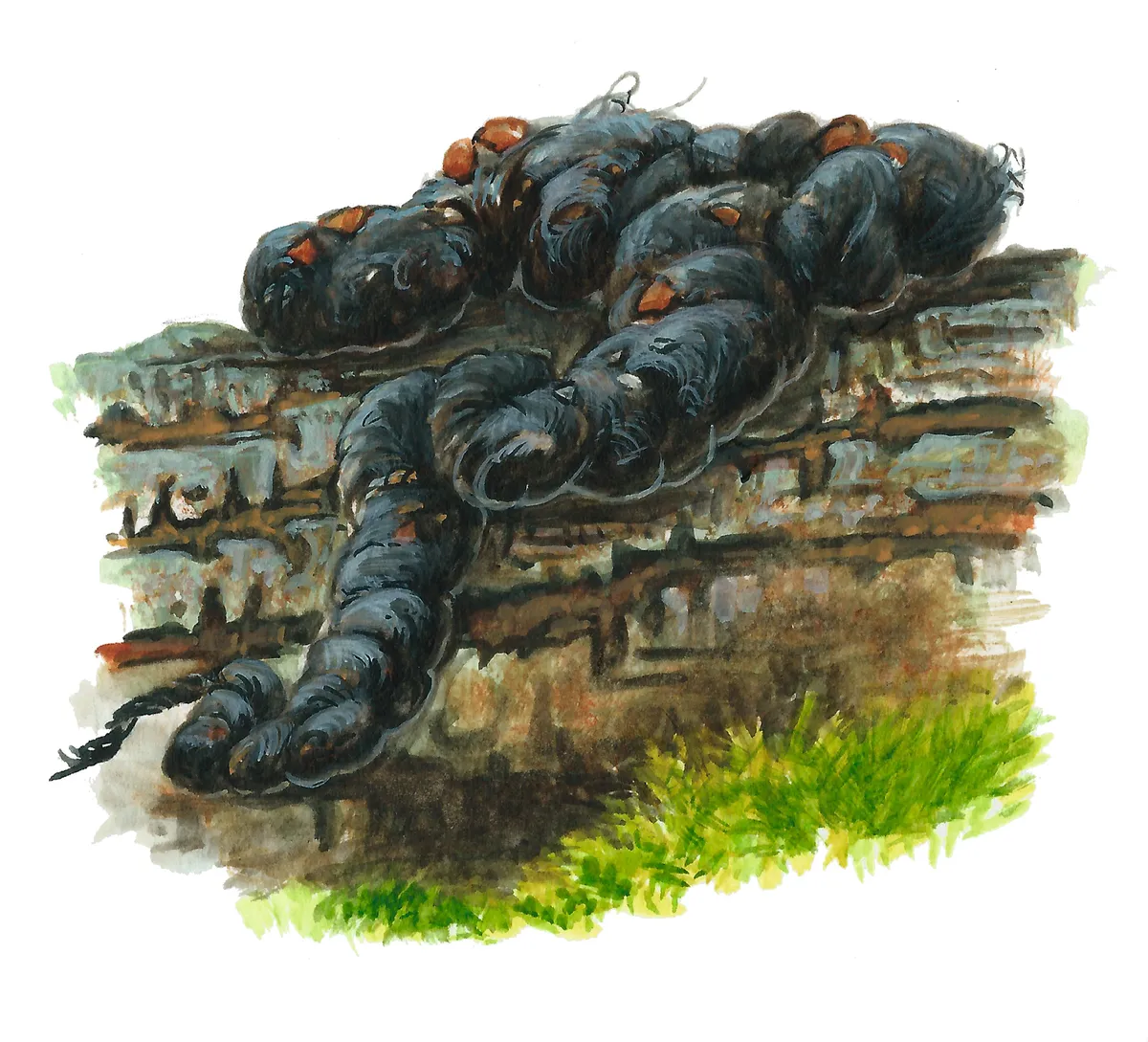
Size: 4–12cm
Pine marten poo is long, thin, coiled and tapered in shape, and full of fur, bone, feathers, pieces of leaves and grass. When defecating, martens wriggle their hips, resulting in twisted poo. In summer, the scat can actually become blue in colour as bilberries can make up to 30 per cent of a pine marten's diet during this season.
Like otter spraint, pine marten poo has a distinctive smell, though it lacks the fishy smell of spraint. It is very musky, sweet and fruity, and does not smell unpleasant - it is sometimes compared to damp hay or parma violets. The scent is one of the key factors for distinguishing the scat from fox poo (however if a fox has been feeding on a lot of berries, it may also smell quite sweet).
Look out for pine marten scat at regular latrines, such as a log or boulder. Also note that you're extremely unlikely to see pine marten poo anywhere but Scotland in the UK.
The scientific name of the pine marten, Martes martes, is an example of a tautonym, where the genus and specific name are the same.
European polecat (Mustela putorius)
Size: 6-8cm long (and 1cm thick)
Like the scats of other small mustelids, the droppings of polecats are dark, twisted and cigarette-sized, measuring 6-8cm long (and 1cm thick). “However, unlike other carnivores such as foxes, pine martens and otters, polecats don’t leave their scats in obvious places in their territory,” says Lizzie Croose, senior carnivore conservation officer at Vincent Wildlife Trust. “Scats are usually left in or close to den sites and may accumulate into substantial piles.” Polecat scat often contains fur from prey and smells unpleasant.
In-situ, polecat droppings can be very difficult to distinguish from those of American mink or feral ferrets. However DNA analysis of the scat can be used to confirm identity.
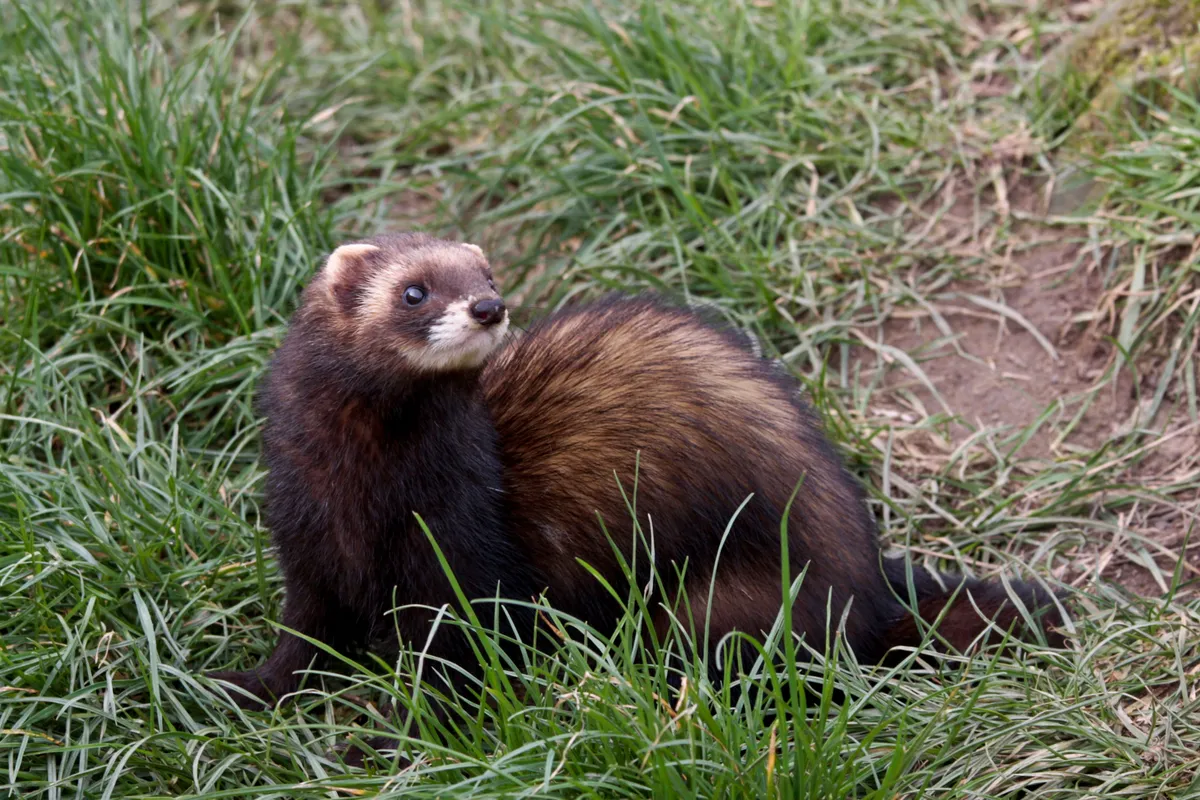
European rabbit poo (Oryctolagus cuniculus)
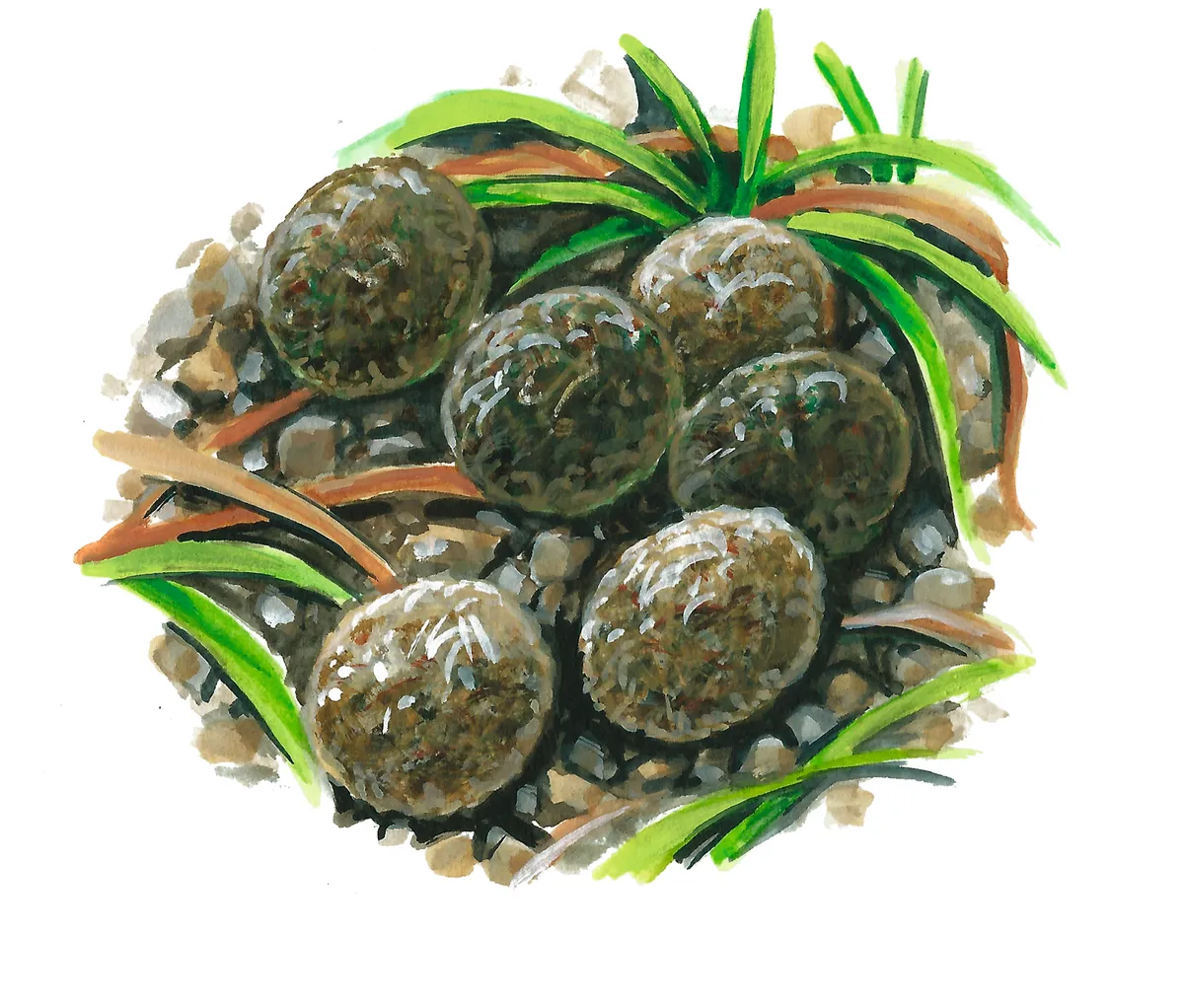
Size: Less than 1cm
Rabbit poo is very small - only pea-sized - and is usually black, light-brown or green in colour. It is filled with plant and grass pieces.
Look out for rabbit droppings scattered at latrines, which are often near burrow entrances.
Rat poo
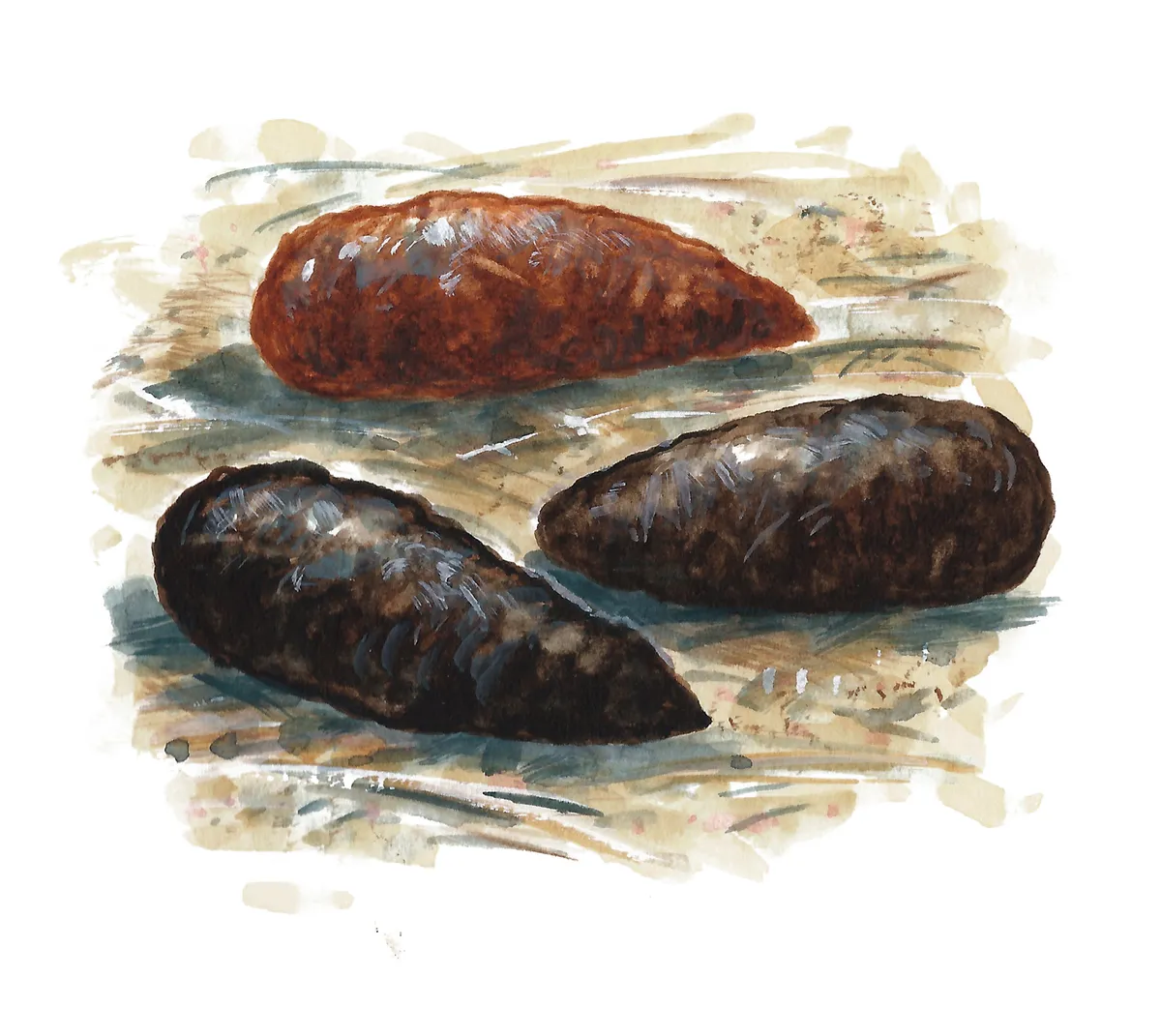
Size: 1.7–2cm
Rat droppings are large and oval-shaped, like olive stones. When fresh, rat droppings are dark in colour, rough in texture, and tapering to a point at one or both ends.
They're often deposited in a scattered group.
Learn how to get rid of rats and mice in your house
Identify the signs they leave, what problems they cause, how to get rid or rats and mice humanely and how to prevent them returning to your home.
© Getty
Roe deer poo (Capreolus capreolus)
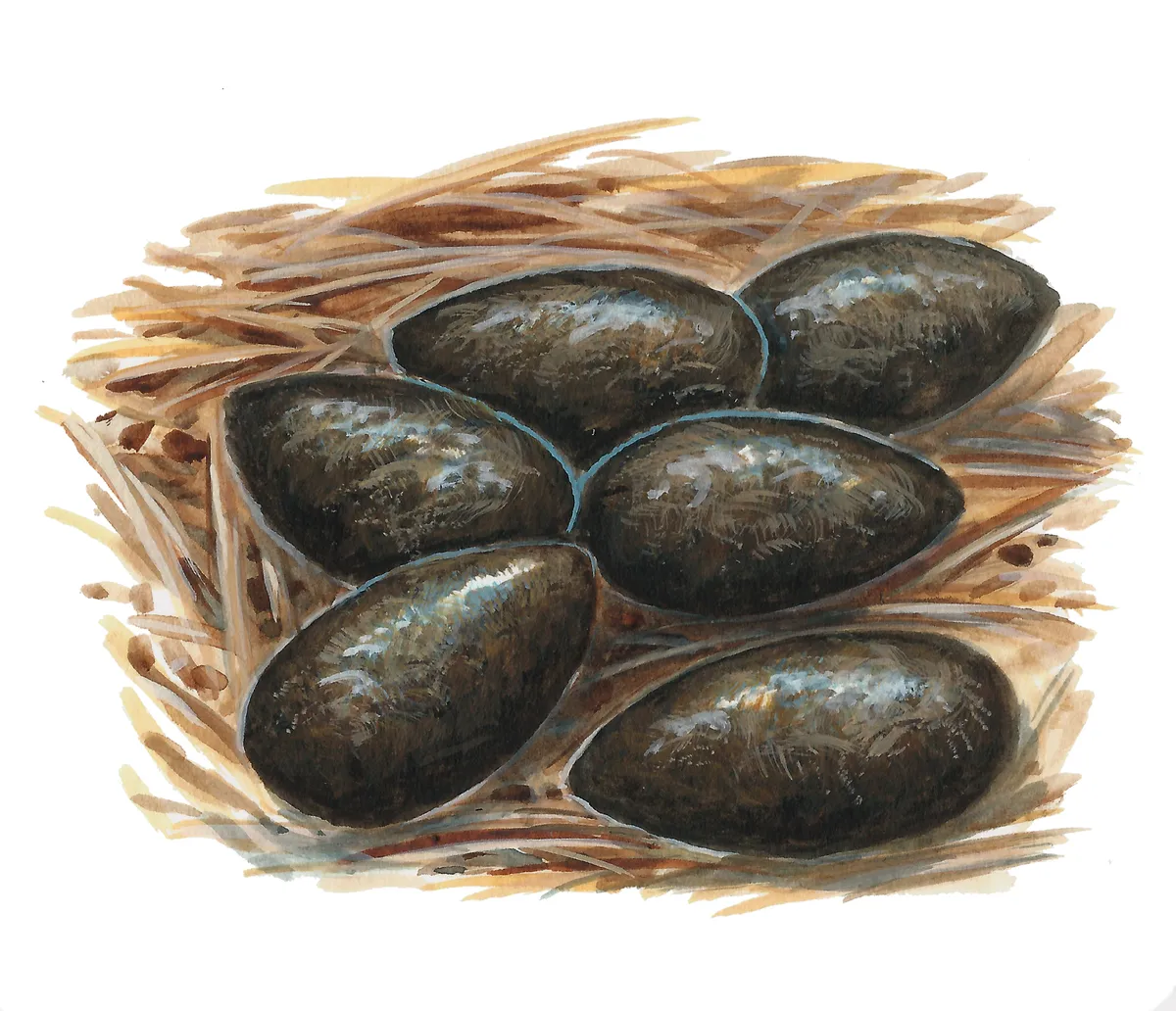
Size: 1–1.4cm
Roe deer poo is relatively small, and usually shiny and brown. Deer ruminate so their droppings don't normally have any obvious contents as their food is finely digested.
The droppings are oval-shaped, with one end pointed and the other end indented or flat. They are usually in clusters, and can be found along paths, or in fields and woodlands.
The scientific name of the roe deer, Capreolus capreolus, is an example of a tautonym, where the genus and specific name are the same.
European water vole (Arvicola amphibius)
Size: 8-12mm
Water voles eat a variety of wetland plants, roots, berries and tubers, and they nibble short grass lawns outside their burrows. Grouped together in latrines, water vole droppings are used to mark out territories, as these sweet-looking mammals are actually highly territorial.
The droppings measure between 8-12mm long, and can be confused with rat poo. However, water vole droppings have blunt ends and are green-black in colour, whereas rat droppings are larger, smelly, pointed at one end and brown-black in colour. “Water vole droppings are odourless, so they mark their territories by rubbing their hind feet on scent glands and drumming them into their droppings, leaving a flattened appearance,” Emily Sabin from the People’s Trust for Endangered Species.
Finding droppings is one of the key indicators of a water vole's presence on a stream or river, as the rodents can be quite hard to spot. Feeding signs are also another indicator – look out for small piles of grass stalks nibbled at a 45-degree angle.

Wild boar (Sus scrofa)
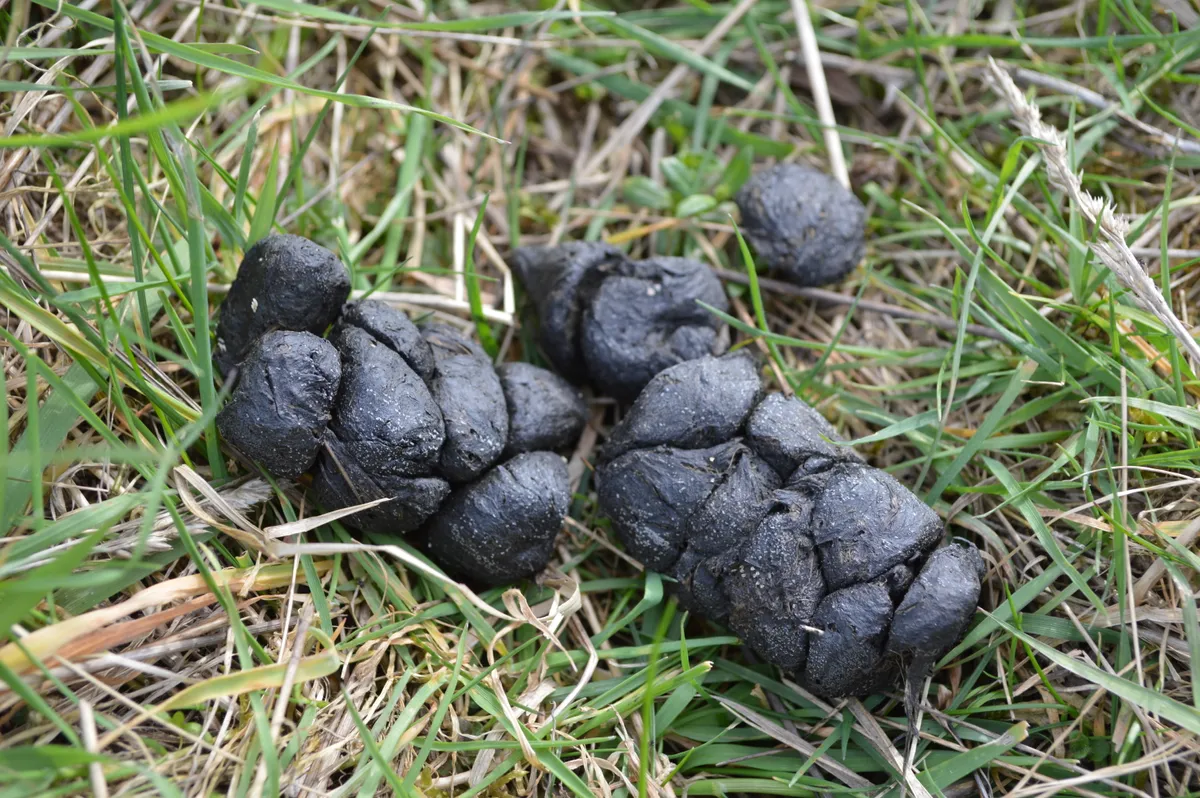
Size: 10cm
Look out for sausage-shaped droppings, which are roughly 10cm in length and have a fibrous consistency as wild boar mostly eat plants. Unlike deer droppings, wild boar droppings stay together when when dry.
“Wild boar make no effort to hide their droppings and like to defecate in communal areas, so if you find one dropping, you’re likely to find a lot more of it close by,” says naturalist Chantal Lyons, who is writing a book on wild boar in the UK.
“Dung beetles go wild for the droppings, although may be eaten by the boar in turn. I’ve been told by a resident of the Forest of Dean that in summer, boar droppings can sometimes be seen glittering with the shattered carapaces of consumed beetles.”
As wild boar root through the earth, eating bulbs, roots, nuts, seeds and more, they also ingest the spores of mycorrhizal fungi, which they then disperse through their droppings.
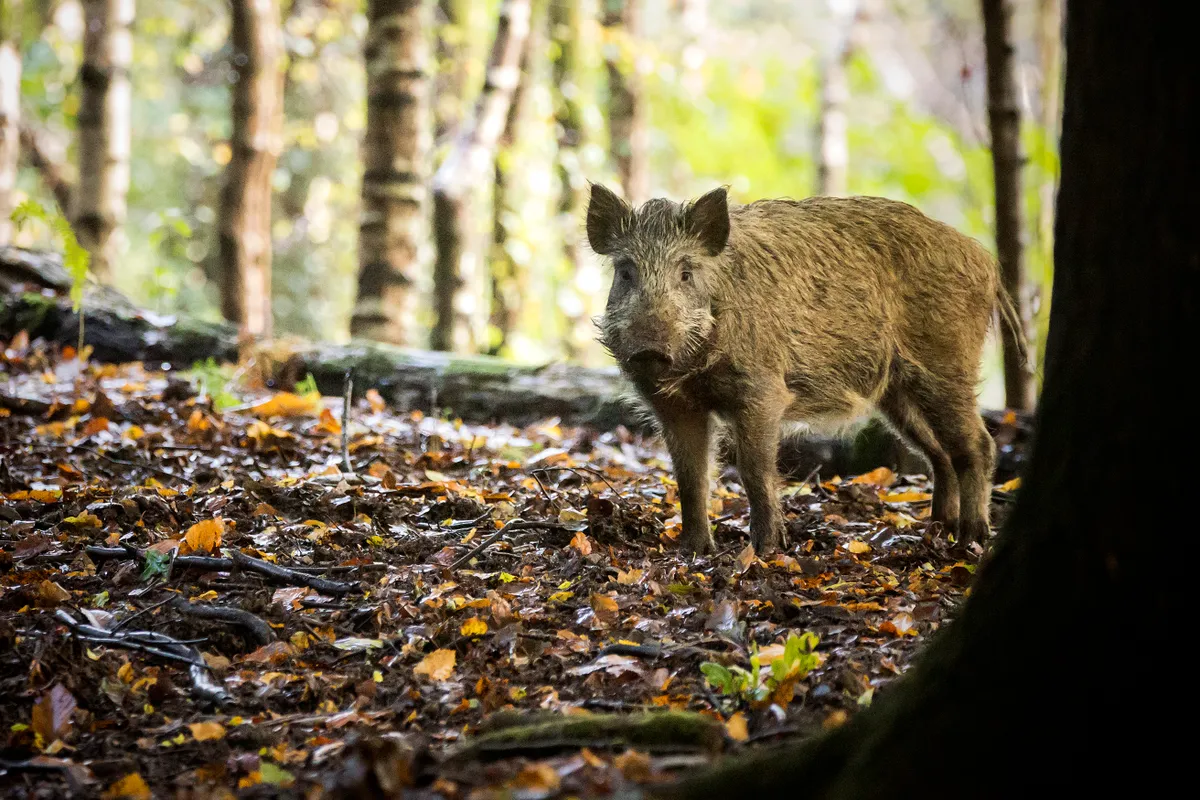
Wolverine (Gulo gulo)
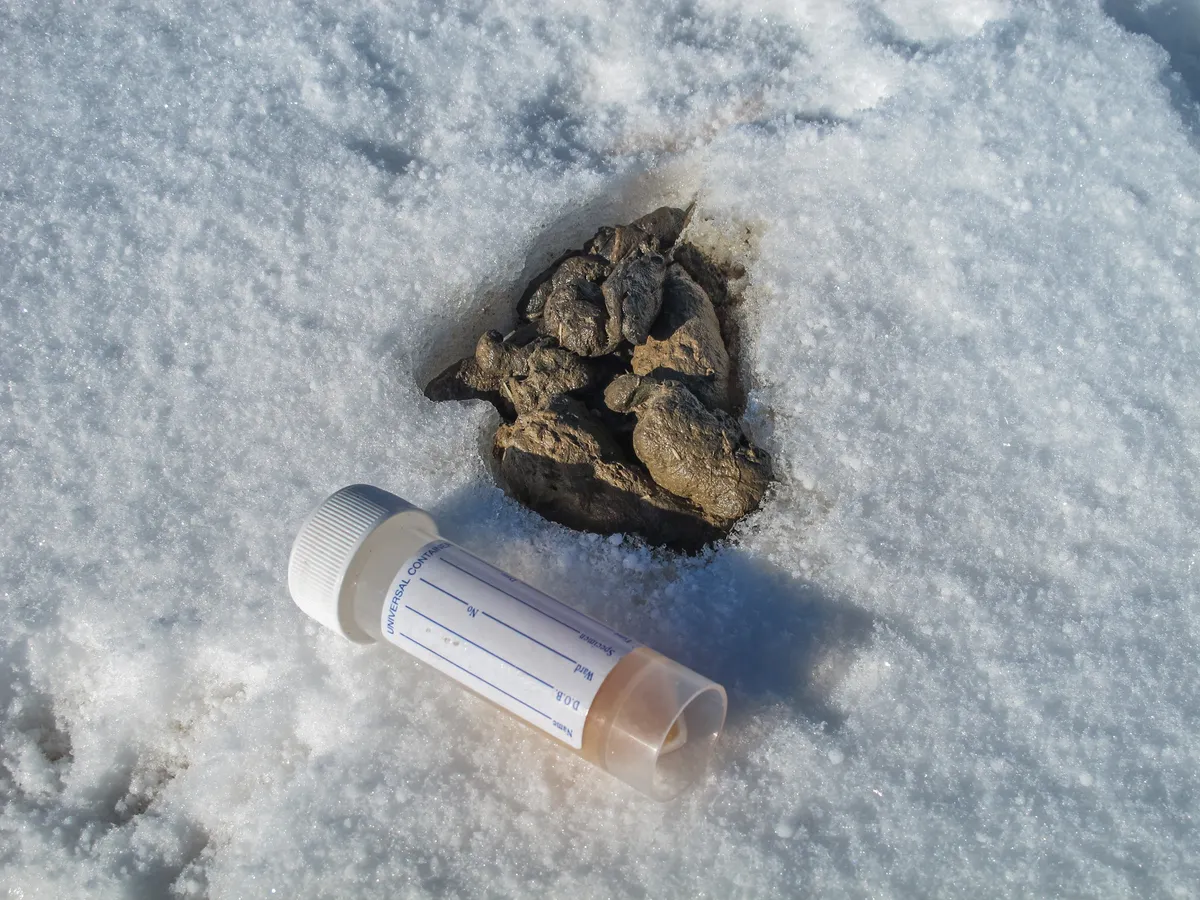
Size: 2.5cm thick
The largest terrestrial member of the mustelid family can take down surprisingly big prey – such as reindeer. However, the wolverine is primarily a scavenger, feeding on carrion that it finds or steals. “Its scat differs depending on what it has been eating,” says Jenny Mattisson from the Norwegian Institute for Nature Research (NINA). “It’s white and dry when the carnivore consumes a lot of bones and is to similar to wolf scat when it eats fresh meat (grey-brown in colour but smaller in size).” Scats containing berries and fungi have also been found but are more rare.
Like other mustelid droppings, wolverine scat is twisted and tapered and may double back on itself in longer scats.
The scientific name of the wolverine, Gulo gulo, is an example of a tautonym, where the genus and specific name are the same.
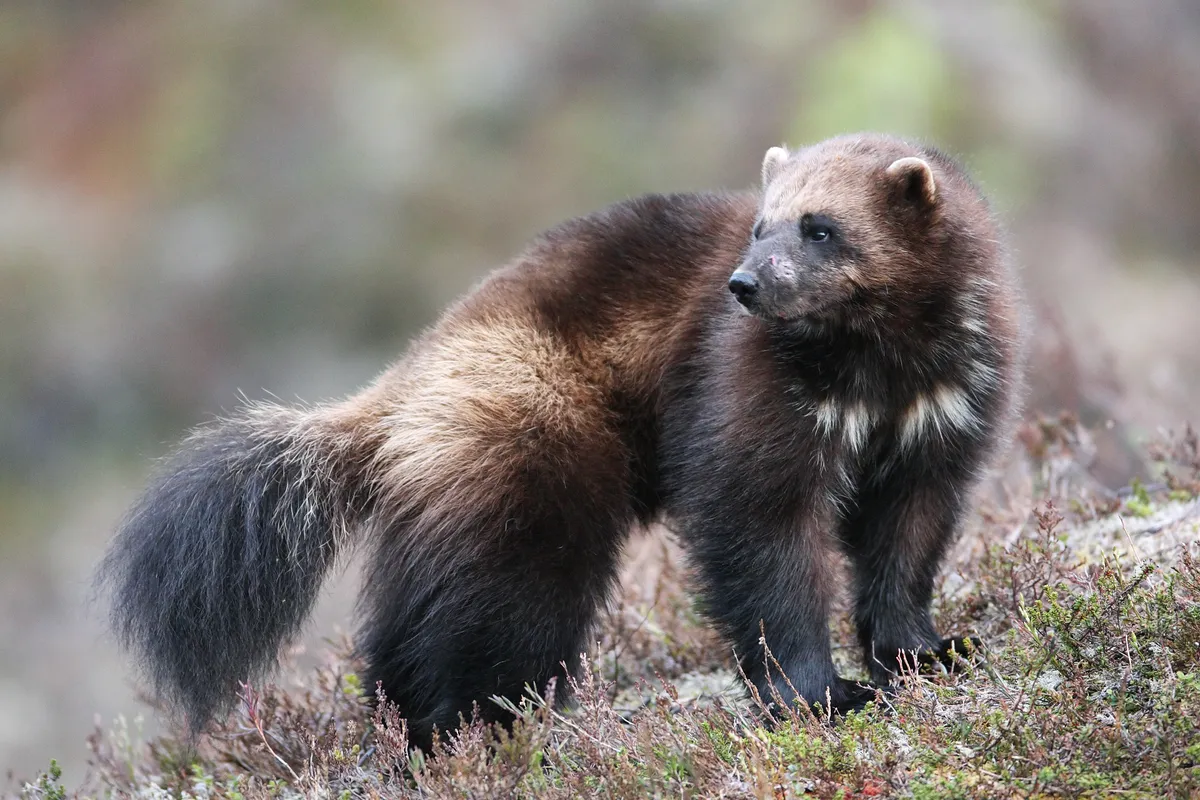
Identifying bird poo
Canada goose poo (Branta canadensis)
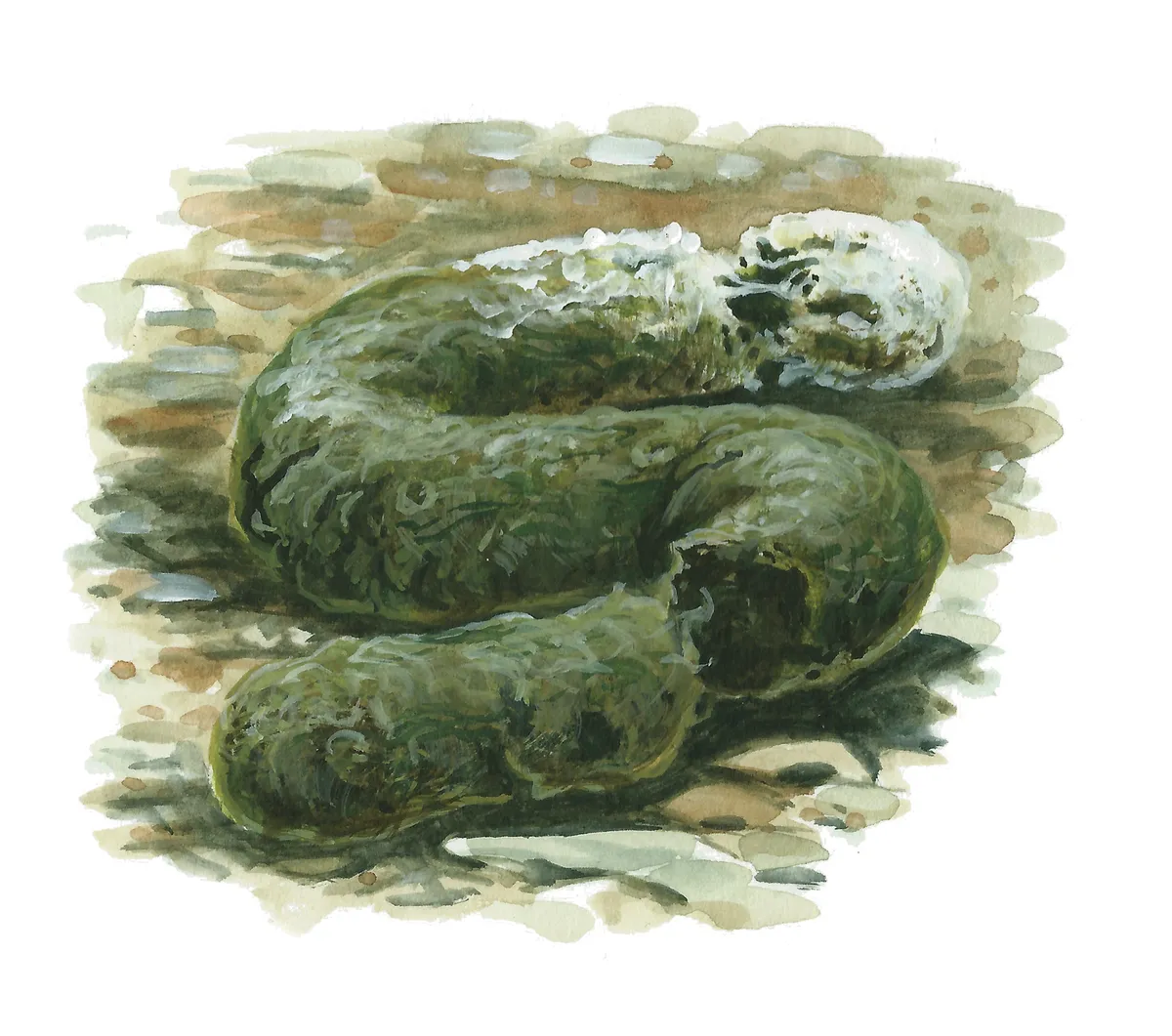
Size: 8cm
Canada goose poo is thick, cylindrical and coiled, with an outer layer of white uric acid. It is mainly made up of digested grass. Usually found in grass and on paths near rivers and ponds.
Green woodpecker poo (Picus viridis)
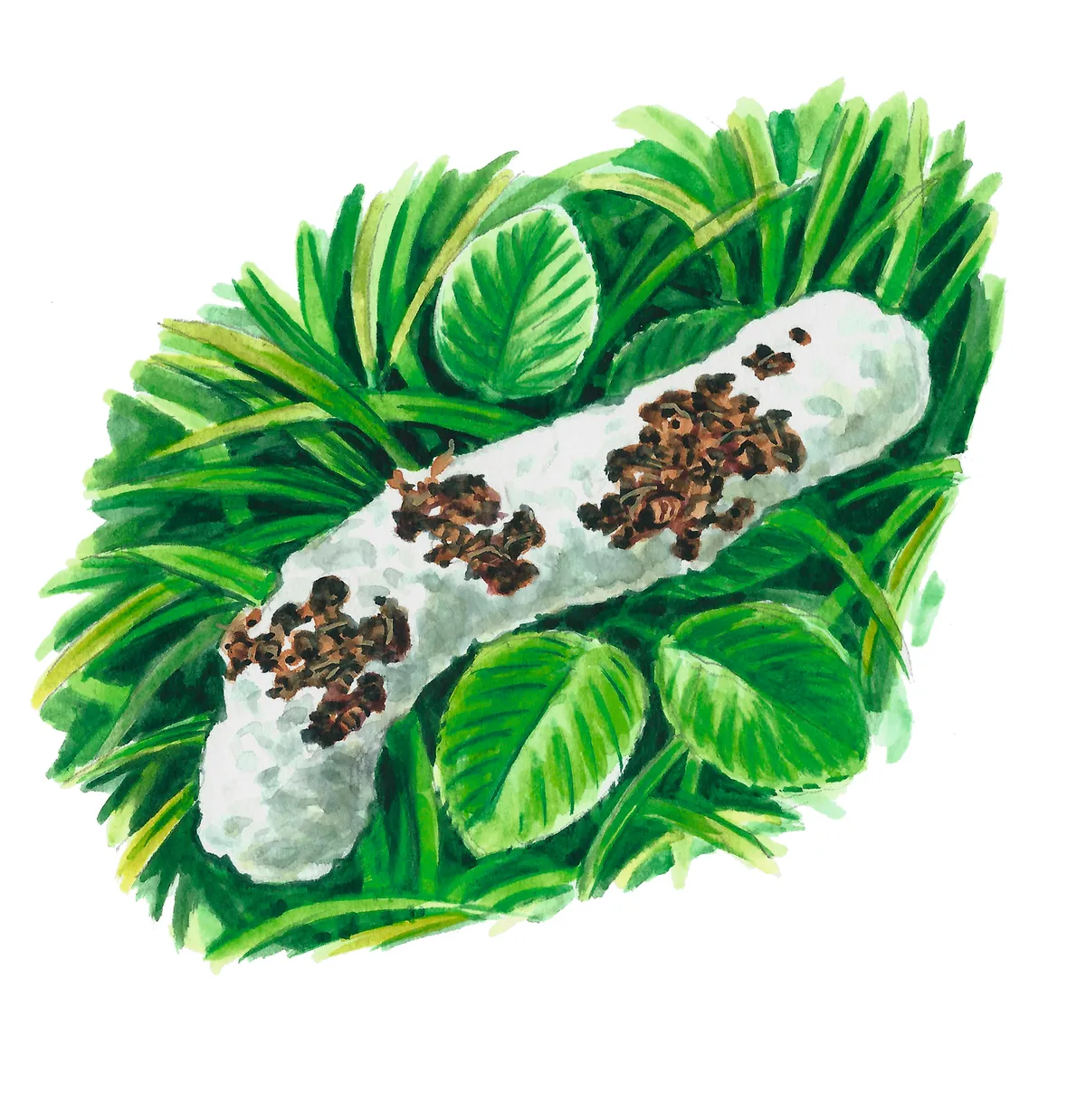
Size: 3–5cm
Green woodpecker poo is short, thin, cylindrical, and looks like cigarette ash. It is dark with coat of white uric acid, and contains ant exoskeletons. Found on lawns.
Common pheasant poo (Phasianus colchicus)
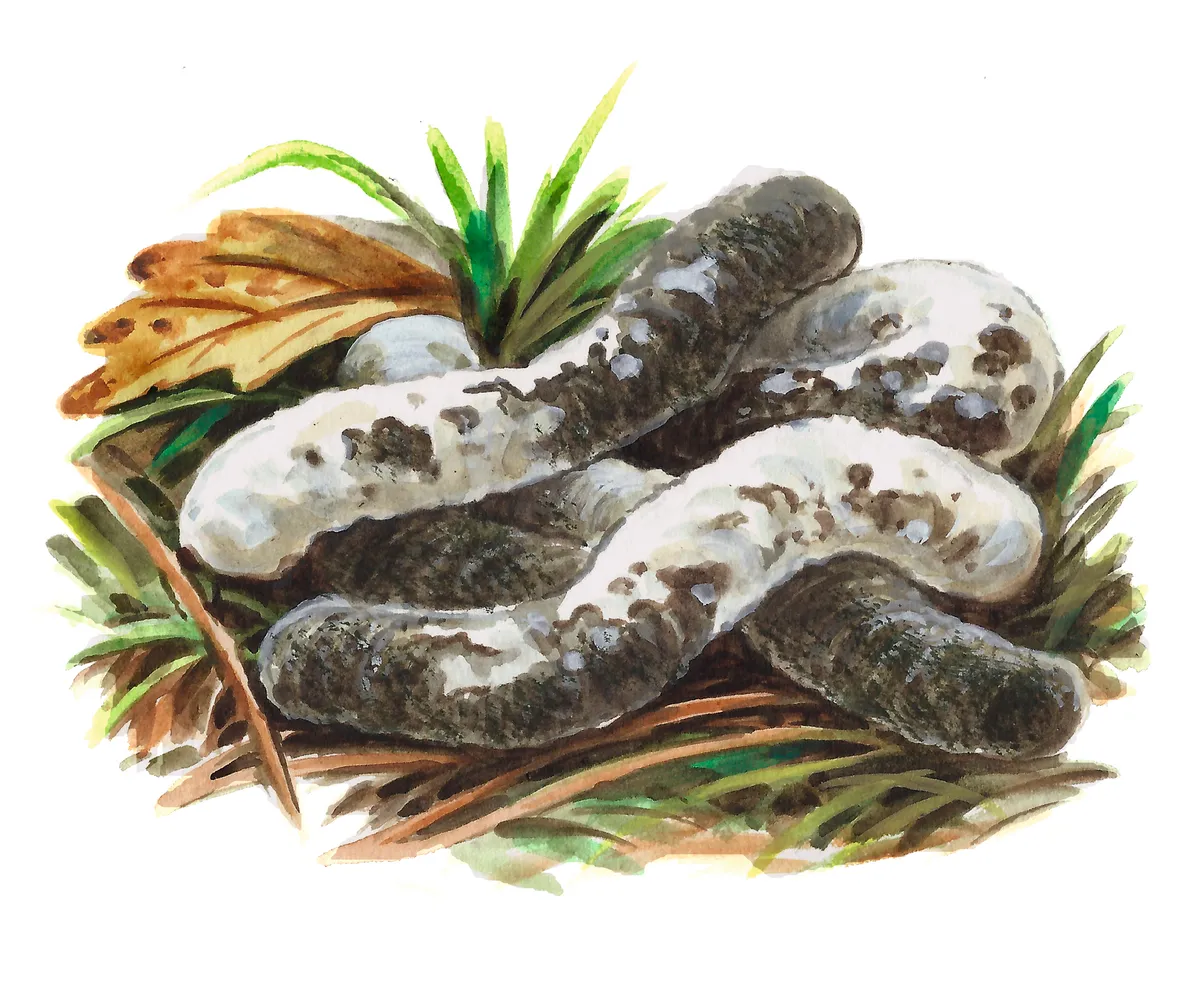
Size: 2cm
Pheasant poo is thick, tubular, and all one big mass, like soft-serve ice cream. It is grey-green in colour, but can often be coated in white, which is uric acid.
Identifying insect poo
Noble chafer beetle (Gnorimus nobilis)
Size: 2mm.
Rare in the UK and listed as a Priority Species for conservation, noble chafer beetles are found in old, hollowing fruit trees in traditional orchards and in old beech and oak trees in the New Forest. The adults are metallic green in colour, with small cream markings.
They are similar in size and shape to the much more common species, the rose chafer beetle (Cetonia aurata). The key difference between the two species is the shape of the triangular area between the top of the elytra (the wing cases). In the noble chafer, this is shorter than in the rose chafer. The noble chafer also has more of a ‘waist’ between its thorax and abdomen.
“The larvae feed on the rotting heartwood inside living trees, and produce droppings called frass which are found inside cavities in branches and the main trunk of the tree.,” says Laura Bower, conservation officer at the People’s Trust for Endangered Species. “Sometimes you just find frass scattered amongst the wood mould but occasionally, if you disturb a loose piece of bark, it can pour out of the base of hollow trees.”
The frass pellets measure approximately 2mm in length, and are brown and cylindrical, without a smell.
Looking for frass is one of the best ways to identify if noble chafer beetles are present in an orchard or woodland. Although the species are iridescent green, they are elusive and are only active for between two to three weeks in June.
“Looking for frass is a good way to survey them during the months when they are larvae or when they’re not active, says Bower. “Noble chafer surveyors are usually seen wandering around orchards with a long-handled spoon! Usually fashioned from a sundae spoon attached to a stick, these are great for reaching into cavities.”
Cowpat connaisseurs: species on animal poo
If you’ve ever taken a closer look at animal droppings, you may have noticed insects moving about them or fungi sprouting up, making use of all the tasty nutrients that can be found. Naturalist, presenter and author Brett Westwood takes a closer look at three of the species you might spot:
Dung beetle (Aphodius rufipes)
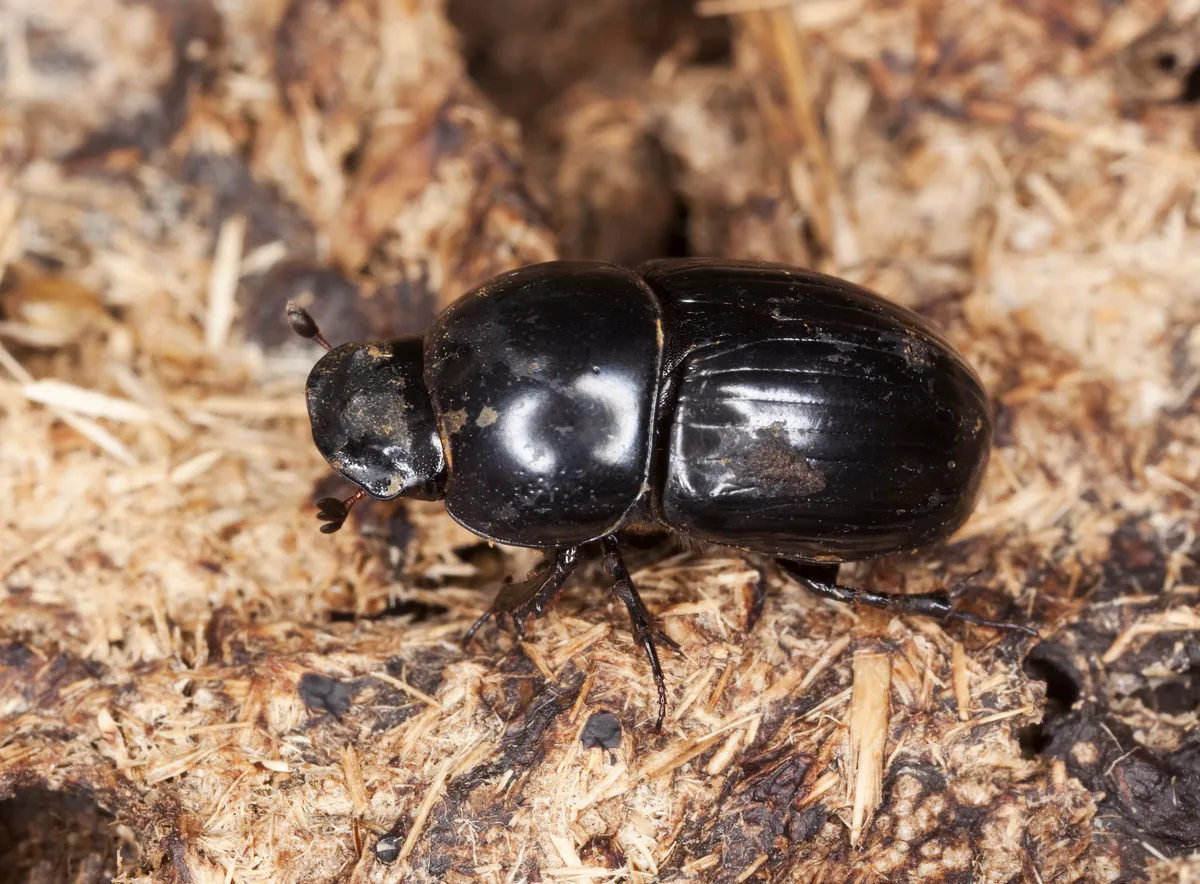
Sinister tapping on the outside of house windows on balmy summer nights can be alarming, but in rural areas it often turns out to be just a harmless dung beetle Aphodius rufipes. This abundant insect is strongly attracted to light. One of several similar species, it is 12mm long with dark, shiny wingcases. It munches cowpats and lays its eggs in them, but – unlike larger scarab beetles – doesn’t bury the dung.
Yellow dung fly (Scathophaga stercoraria)
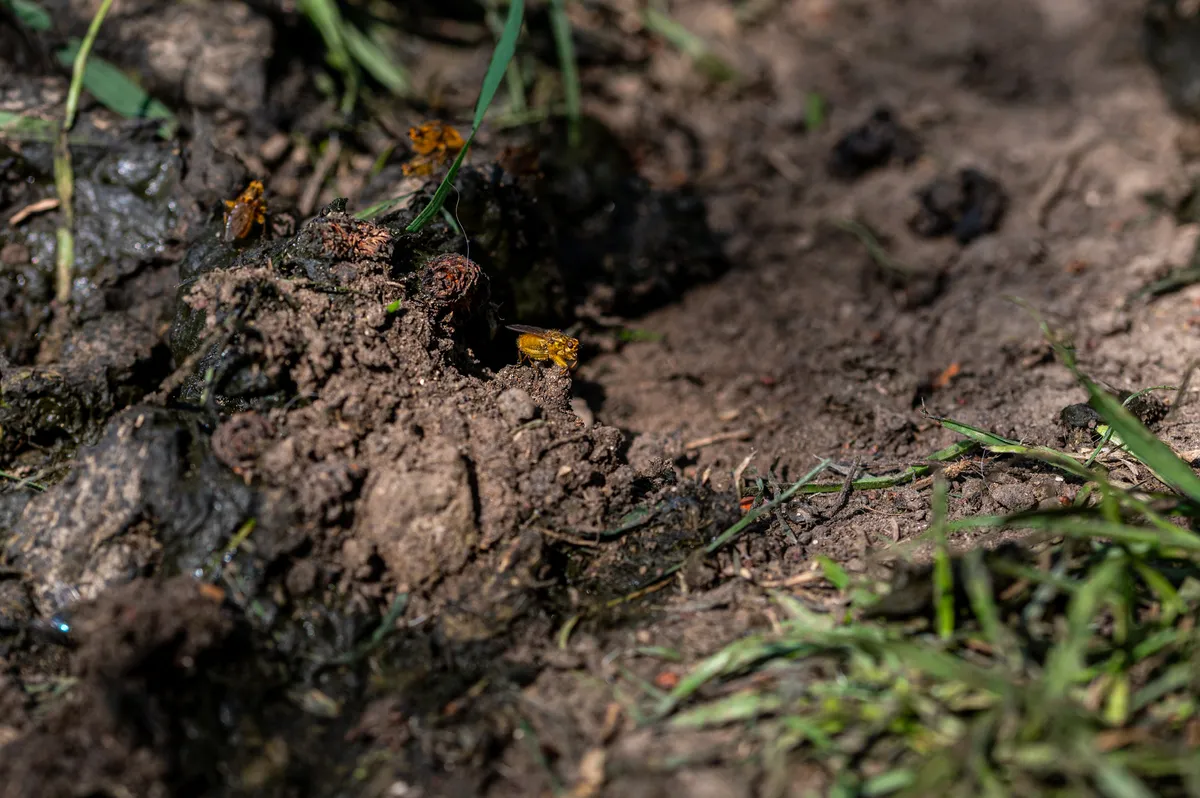
Beetles aren’t the only denizens of dung. For the yellow dung fly (Scathophaga stercoraria), fresh dollops of bovine excrement serve as a hunting ground, jousting arena, mating bed and nursery for its eggs and larvae. The stout male (pictured) bristles with mustard hairs and can be seen all year round; the female is greyish-green. Both sexes prey on small insects, sucking them dry. They are one of the favourite foods of lesser horseshoe bats.
Yellow field cap (Bolbitius vitellinus)
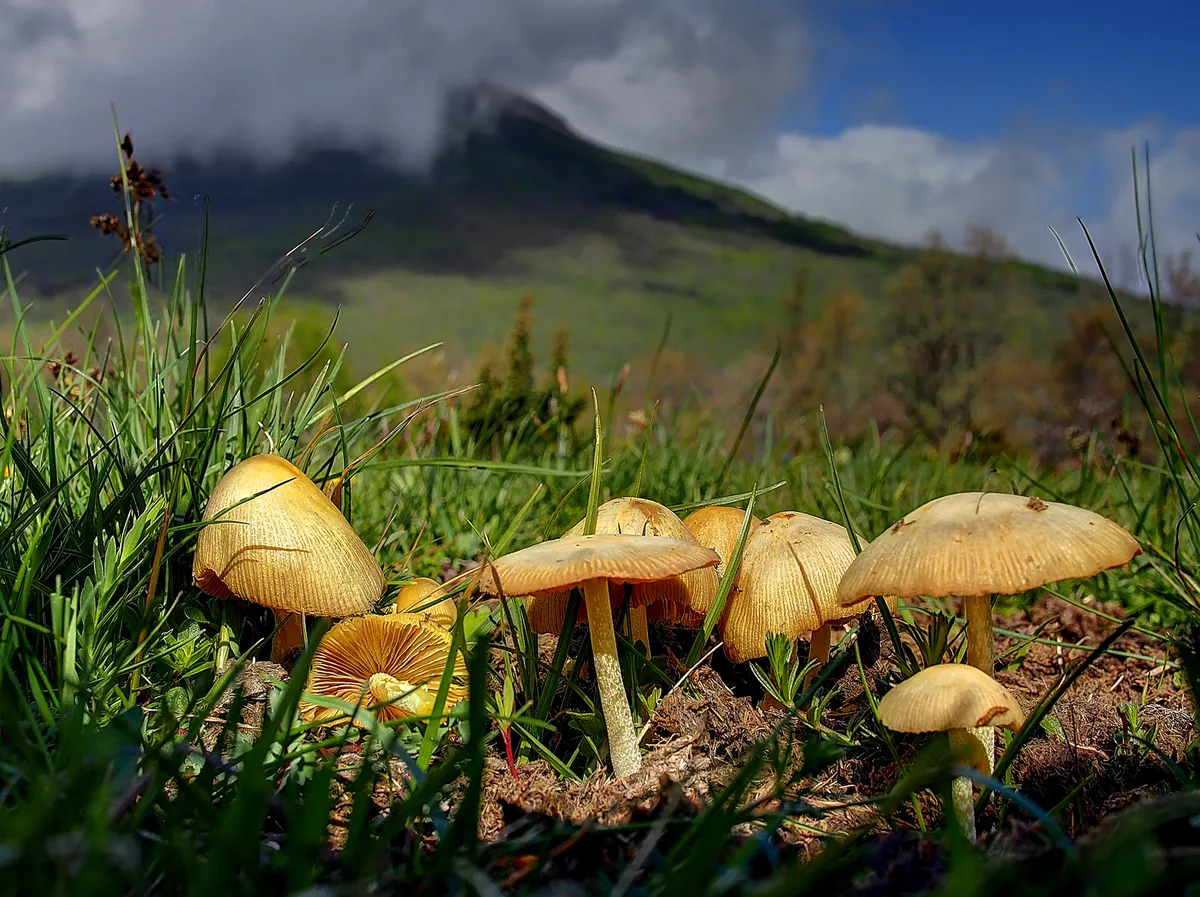
Since cowpats are chock-full of nutrients, it isn’t long before they are colonised by hungry hyphae (the long, thread-like structures of fungi). One of the most obvious dung-loving mushrooms is the yellow field cap (Bolbitius vitellinus), which is bell-shaped and canary-coloured when young, fading and flattening out as it ages. It can be seen all summer and into autumn.
Main image: Red fox. © Getty
